2014年08月31日
Midsummer’s Night Dream
One of the highlights of summer in Takamatsu this year was the Midsummer’s Night Dream Carnival and Waterfront Festival. Held at Takamatsu Port, it was actually part of three digital media art events held concurrently over a 3-week period. These represented a trial run for an even larger festival to be held next year so if you missed it, you can look forward to more fun in 2015!
Highlights included popular interactive displays at etopia in Sunport

and in the Takamatsu Museum of Art,

The main attraction, however, was a dynamic program of holograms projected onto a giant water screen at Takamatsu Port (unfortunately not very compatible with my camera).

On clear nights, this event attracted huge crowds of up to a thousand people. Thanks to the outdoor venue, however, it never felt overcrowded.
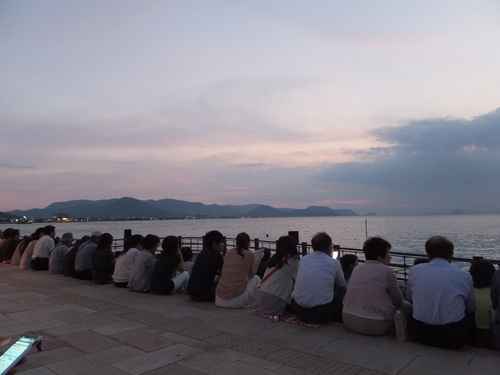
The venue provided the added entertainment of sunset over the Seto Inland Sea.
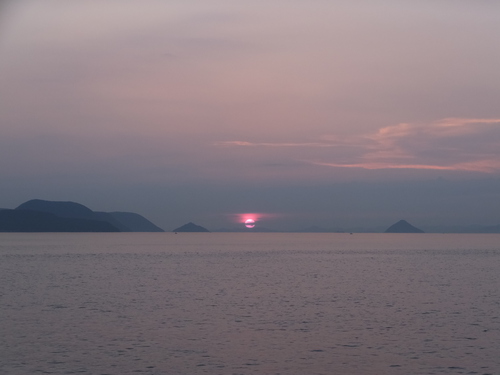
In conjunction with the water screen, which was sponsored by Takamatsu city, the prefecture hosted a portside carnival complete with street performers, dancing, music, and kiosks. I went several times and it was great fun. Different local performers were featured nightly, including a passionate team of flamenco dancers and musicians.

Street buskers included Birdman

and a very entertaining juggler, both from Kanto.

These two transformed into a fire dancing act at night, which was scarily thrilling and quite spectacular in the dark.

They will be back for the Buskers’ Festival in Takamatsu on October 4th, another entertaining annual event with high-caliber free performances. I do recommend having lots of small change on hand, however, as the performers are so good you’ll want to put some money in their hat at the end.
The food provided at the summer event also deserves special mention.
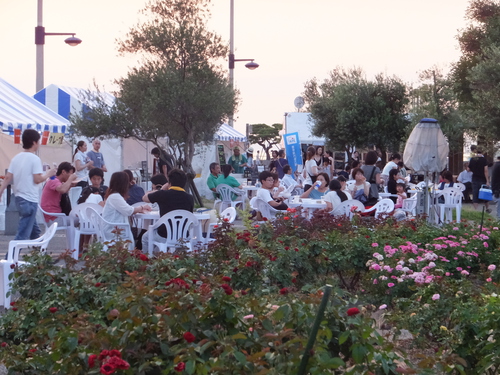
Stalls were run by well-known local entrepreneurs selling delicious fare, including excellent Sanuki noodles, great organic iced coffee made on site, lemon cakes from Teshima island, and specialty beers provided by local Irish pub, The Craic.
I'm looking forward to more next summer!
For more info on Takamatsu:
http://wikitravel.org/en/Takamatsu
http://www.city.takamatsu.kagawa.jp/english/
http://tia-takamatsu.jp/
http://www.my-kagawa.jp/eg/
Other Takamatsu bloggers:
http://pat.ashita-sanuki.jp/
http://setouchiexplorer.com/
Highlights included popular interactive displays at etopia in Sunport
and in the Takamatsu Museum of Art,
The main attraction, however, was a dynamic program of holograms projected onto a giant water screen at Takamatsu Port (unfortunately not very compatible with my camera).
On clear nights, this event attracted huge crowds of up to a thousand people. Thanks to the outdoor venue, however, it never felt overcrowded.
The venue provided the added entertainment of sunset over the Seto Inland Sea.
In conjunction with the water screen, which was sponsored by Takamatsu city, the prefecture hosted a portside carnival complete with street performers, dancing, music, and kiosks. I went several times and it was great fun. Different local performers were featured nightly, including a passionate team of flamenco dancers and musicians.
Street buskers included Birdman
and a very entertaining juggler, both from Kanto.
These two transformed into a fire dancing act at night, which was scarily thrilling and quite spectacular in the dark.
They will be back for the Buskers’ Festival in Takamatsu on October 4th, another entertaining annual event with high-caliber free performances. I do recommend having lots of small change on hand, however, as the performers are so good you’ll want to put some money in their hat at the end.
The food provided at the summer event also deserves special mention.
Stalls were run by well-known local entrepreneurs selling delicious fare, including excellent Sanuki noodles, great organic iced coffee made on site, lemon cakes from Teshima island, and specialty beers provided by local Irish pub, The Craic.
I'm looking forward to more next summer!
For more info on Takamatsu:
http://wikitravel.org/en/Takamatsu
http://www.city.takamatsu.kagawa.jp/english/
http://tia-takamatsu.jp/
http://www.my-kagawa.jp/eg/
Other Takamatsu bloggers:
http://pat.ashita-sanuki.jp/
http://setouchiexplorer.com/
2013年02月01日
Triennale 2013: A Few More Details
So, here I am back with a little more information on the Setouchi Triennale 2013, a contemporary art festival spread across 12 islands in the Seto Inland Sea. The festival makes art fun and accessible to adults and children alike, and showcases the beauty and diversity of the region’s islands and traditional lifestyles.
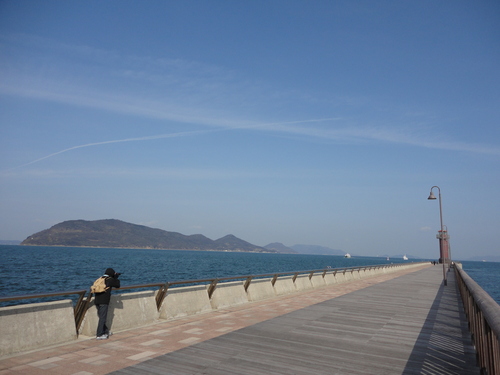
It also inspires visitors to pause and reassess contemporary life.
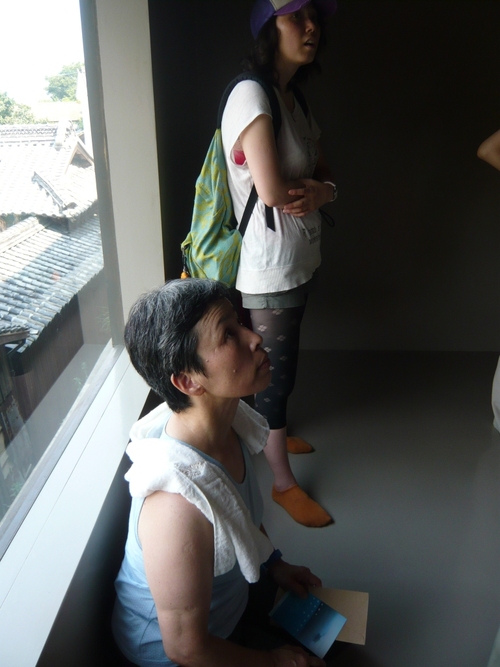
Contemplating
In 2010, almost 1 million visitors traveled to the islands over the space of 100 days. Many came back repeatedly and some stayed on as volunteers, captivated by the festival and the Seto Inland Sea. This year, the festival will be split into three separate seasons: spring (March 20-April 21), summer (July 20-September 1) and autumn (October 5-November 4). If you are not used to hot weather, spring and autumn are the best times to come, but summer is still doable as long as you slow down and take it easy.
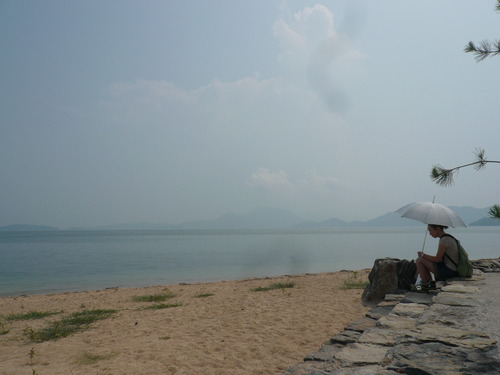
Taking a break on Teshima
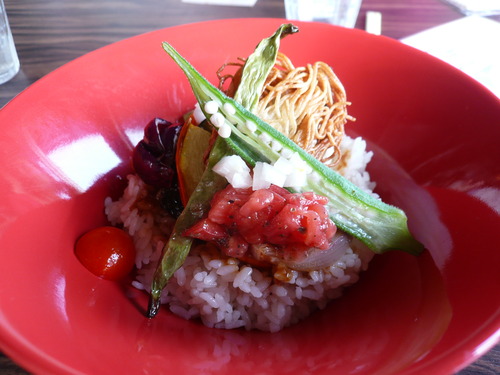
Enjoying artistic cuisine
The number of artists participating has more than doubled from 75 to over 175 and 5 new islands have been added. In addition, Yashima, Takamatsu’s historic tableland (which is also an island!), will be featured (see fellow blogger Pat’s post at http://pat.ashita-sanuki.jp/e623838.html ).

Looking down from Yashima
The festival passports are an amazingly good deal. For just 5,000 yen, you can get a 3-season passport, which provides once-only access to every site (and there are a lot of them!) plus free access or discount access to other famous art facilities. High school students are just 3,500 yen and anyone younger is free! As you can see, the organizers are quite serious about making art accessible to all and the event as family-friendly as possible. (1-season passports are available for 4,500 yen.)
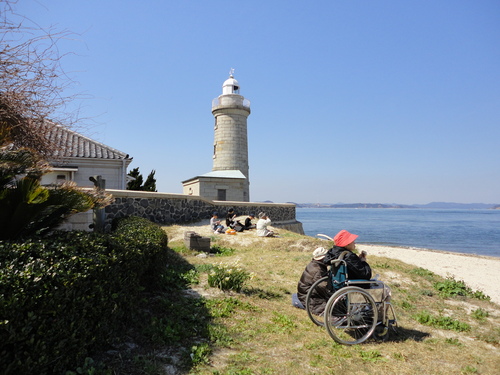
For more information on the festival, visit the Setouchi Triennale 2013 official website:
http://setouchi-artfest.jp/en/
and David’s blog devoted to the festival:
http://ogijima.com/art-setouchi/setouchi-triennale-2013/
Yesterday, I decided to check out what it might be like to arrive as a tourist. I discovered that there is a very good tourist information center just outside JR Takamatsu station with great service in English, Korean and Chinese, as well as multilingual maps and pamphlets. There is also someone who can direct you to hotels, but if you come during the festival, it’s wiser to book in advance.
The tourist information center is not very obvious from the station. Here is what it looks like.
Tourist Information Center
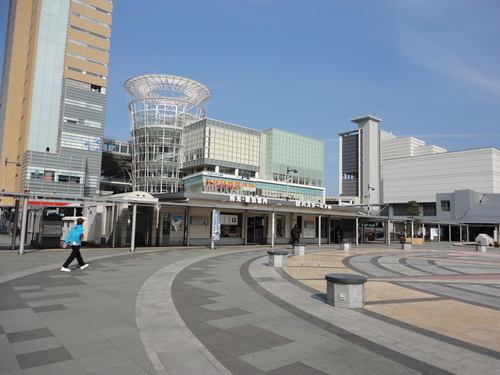
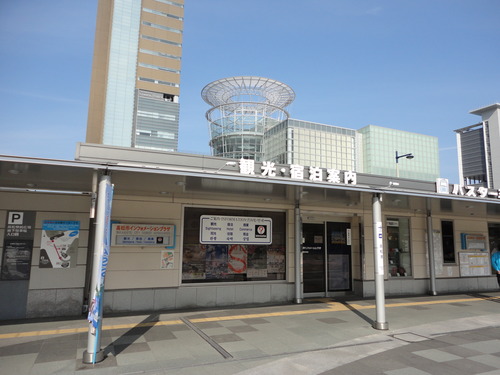
Passports and more detailed assistance concerning the festival are available at the Takamatsu Port General Information Center which is on the other side of the street and a block down from the tourist center across from the port and the ANA Clement Hotel.
Takamatsu Port General Information in the Terminal Building
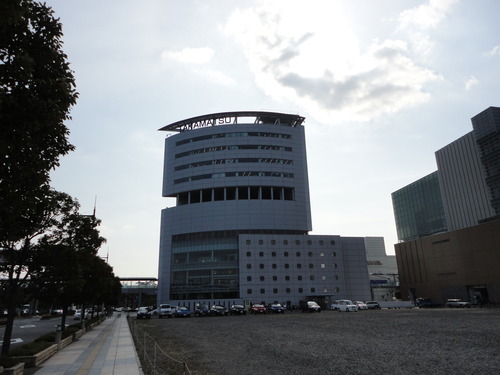
Special Event!
Conversation with the Takumi Masters, March 20-23, 25-29 in Tamamo Park. Exquisite cuisine and traditional Japanese arts. Check here for details:
http://www.takumino-shizuku.jp/index_e.html
Takamatsu Access:
Takamatsu can be reached by direct flights from Tokyo’s Haneda Airport (about 1 hour), by limousine bus from Kansai International Airport (about 3 hours), and by direct flights from China and Korea. It can also be reached by taking the bullet train to Okayama (4 hours from Tokyo) and changing to the Marine Liner bound for Takamatsu (runs every 1/2 hour; takes 1 hour).
Hotels: http://www.japanican.com/index.aspx (when selecting the area of stay, scroll down to “Other Popular Options” and select “Takamatsu/Tokushima/Awashima”.)
Also check: http://www.kagawa-yadonet.or.jp/en/

It also inspires visitors to pause and reassess contemporary life.
Contemplating
In 2010, almost 1 million visitors traveled to the islands over the space of 100 days. Many came back repeatedly and some stayed on as volunteers, captivated by the festival and the Seto Inland Sea. This year, the festival will be split into three separate seasons: spring (March 20-April 21), summer (July 20-September 1) and autumn (October 5-November 4). If you are not used to hot weather, spring and autumn are the best times to come, but summer is still doable as long as you slow down and take it easy.
Taking a break on Teshima
Enjoying artistic cuisine
The number of artists participating has more than doubled from 75 to over 175 and 5 new islands have been added. In addition, Yashima, Takamatsu’s historic tableland (which is also an island!), will be featured (see fellow blogger Pat’s post at http://pat.ashita-sanuki.jp/e623838.html ).
Looking down from Yashima
The festival passports are an amazingly good deal. For just 5,000 yen, you can get a 3-season passport, which provides once-only access to every site (and there are a lot of them!) plus free access or discount access to other famous art facilities. High school students are just 3,500 yen and anyone younger is free! As you can see, the organizers are quite serious about making art accessible to all and the event as family-friendly as possible. (1-season passports are available for 4,500 yen.)
For more information on the festival, visit the Setouchi Triennale 2013 official website:
http://setouchi-artfest.jp/en/
and David’s blog devoted to the festival:
http://ogijima.com/art-setouchi/setouchi-triennale-2013/
Yesterday, I decided to check out what it might be like to arrive as a tourist. I discovered that there is a very good tourist information center just outside JR Takamatsu station with great service in English, Korean and Chinese, as well as multilingual maps and pamphlets. There is also someone who can direct you to hotels, but if you come during the festival, it’s wiser to book in advance.
The tourist information center is not very obvious from the station. Here is what it looks like.
Tourist Information Center


Passports and more detailed assistance concerning the festival are available at the Takamatsu Port General Information Center which is on the other side of the street and a block down from the tourist center across from the port and the ANA Clement Hotel.
Takamatsu Port General Information in the Terminal Building

Special Event!
Conversation with the Takumi Masters, March 20-23, 25-29 in Tamamo Park. Exquisite cuisine and traditional Japanese arts. Check here for details:
http://www.takumino-shizuku.jp/index_e.html
Takamatsu Access:
Takamatsu can be reached by direct flights from Tokyo’s Haneda Airport (about 1 hour), by limousine bus from Kansai International Airport (about 3 hours), and by direct flights from China and Korea. It can also be reached by taking the bullet train to Okayama (4 hours from Tokyo) and changing to the Marine Liner bound for Takamatsu (runs every 1/2 hour; takes 1 hour).
Hotels: http://www.japanican.com/index.aspx (when selecting the area of stay, scroll down to “Other Popular Options” and select “Takamatsu/Tokushima/Awashima”.)
Also check: http://www.kagawa-yadonet.or.jp/en/
2013年01月31日
Countdown to Setouchi Triennale 2013
Just 48 days left and counting until the Setouchi Triennale, one of the most amazing contemporary art festivals in Japan. This year promises to be a fitting sequel to Art Setouchi 2010.

"Liminal Air-Core", Takamatsu Port
A far cry from static installations in museum settings, the art festival spreads over the islands of the beautiful Seto Inland Sea. Site specific art and fusions of art and architecture are set like gems into the natural scenery. Many works are being created right now in collaboration with local residents and hundreds of volunteers, while others are the legacy of the previous festival in 2010.

"Ogijima's Soul", Jauma Plensa
The performing arts are also featured. A variety of concerts, theatric performances and interactive events are being planned. In fact, interaction is a key theme and, whether you like contemporary art or not, this element coupled with island hopping by local ferry makes the festival just plain fun!
Having fun on the ferry in 2010


This year, 12 islands are involved, up from 7 islands last time, and close to 180 artists from 22 countries are participating (or 300 artists if you count the group of artists and artisans from Bangladesh arriving this summer). Many of these artists are up and coming names in contemporary art and architecture, while others have already won international acclaim, such as architect Ando Tadao and artists Lee Ufan, and Takeshi Kitano (who is also an award-winning film director).

The Triennale’s aims are ambitious: to become a driving force in the revitalization of the islands and the restoration of the sea, to connect people from all over the world, share their wisdom and explore how we can create a vibrant lifestyle in harmony with nature, and to provide an alternative to globalization―one that celebrates diversity.
"Oiwa Island", Oscar Oiwa

2010 was an excellent start and I’m looking forward to seeing how the Setouchi Triennale 2013 builds on that foundation. If you love nature, if you love art and architecture, if you are attracted to the slow life or wish to explore alternative approaches for the future, don’t miss this festival!

Check my next article for more details. In the meantime, remember that Takamatsu is an excellent base from which to explore the festival and the beauty of the inland sea region.
Takamatsu Access:
Takamatsu can be reached by direct flights from Tokyo’s Haneda Airport (about 1 hour), by limousine bus from Kansai International Airport (about 3 hours), and by direct flights from China and Korea. It can also be reached by taking the bullet train to Okayama (4 hours from Tokyo) and changing to the Marine Liner bound for Takamatsu (runs every 1/2 hour; takes 1 hour).
Hotels: http://www.japanican.com/index.aspx (when selecting the area of stay, scroll down to “Other Popular Options” and select “Takamatsu/Tokushima/Awashima”.)
Also check: http://www.kagawa-yadonet.or.jp/en/

"Liminal Air-Core", Takamatsu Port
A far cry from static installations in museum settings, the art festival spreads over the islands of the beautiful Seto Inland Sea. Site specific art and fusions of art and architecture are set like gems into the natural scenery. Many works are being created right now in collaboration with local residents and hundreds of volunteers, while others are the legacy of the previous festival in 2010.
"Ogijima's Soul", Jauma Plensa
The performing arts are also featured. A variety of concerts, theatric performances and interactive events are being planned. In fact, interaction is a key theme and, whether you like contemporary art or not, this element coupled with island hopping by local ferry makes the festival just plain fun!
Having fun on the ferry in 2010
This year, 12 islands are involved, up from 7 islands last time, and close to 180 artists from 22 countries are participating (or 300 artists if you count the group of artists and artisans from Bangladesh arriving this summer). Many of these artists are up and coming names in contemporary art and architecture, while others have already won international acclaim, such as architect Ando Tadao and artists Lee Ufan, and Takeshi Kitano (who is also an award-winning film director).

The Triennale’s aims are ambitious: to become a driving force in the revitalization of the islands and the restoration of the sea, to connect people from all over the world, share their wisdom and explore how we can create a vibrant lifestyle in harmony with nature, and to provide an alternative to globalization―one that celebrates diversity.
"Oiwa Island", Oscar Oiwa
2010 was an excellent start and I’m looking forward to seeing how the Setouchi Triennale 2013 builds on that foundation. If you love nature, if you love art and architecture, if you are attracted to the slow life or wish to explore alternative approaches for the future, don’t miss this festival!
Check my next article for more details. In the meantime, remember that Takamatsu is an excellent base from which to explore the festival and the beauty of the inland sea region.
Takamatsu Access:
Takamatsu can be reached by direct flights from Tokyo’s Haneda Airport (about 1 hour), by limousine bus from Kansai International Airport (about 3 hours), and by direct flights from China and Korea. It can also be reached by taking the bullet train to Okayama (4 hours from Tokyo) and changing to the Marine Liner bound for Takamatsu (runs every 1/2 hour; takes 1 hour).
Hotels: http://www.japanican.com/index.aspx (when selecting the area of stay, scroll down to “Other Popular Options” and select “Takamatsu/Tokushima/Awashima”.)
Also check: http://www.kagawa-yadonet.or.jp/en/
2011年12月20日
‘Art-full’ Dining Tokiwa Saryo
Here’s another gem hidden away in the central Takamatsu: Japanese restaurant Tokiwa Saryo.

Tokiwa Saryo Restaurant
Located just one street south of the Tokiwa-gai arcade, this restaurant is closely connected to the shopping district’s history. It was built in the early 1950s by Jukichi Mizobuchi, a prominent local producer involved in theater, movies and events. Mizobuchi had already built a theater nearby, stimulating the development of a shopping arcade in this area.

Entrance
Tokiwa Saryo started out as a very posh inn. The design was so elaborate that construction took 4 years to complete. The distinctive golden fish and blue tiles that topped the castle-like structure could be seen all the way from Takamatsu Station when it was first built and it numbered among its clientele many famous people from showbiz, commerce and politics.
Due to modern fire regulations, the top floors are no longer used as a hotel, but the bottom two floors have been converted into a spectacular restaurant replete with inner courtyard garden and pond.

Dining area viewed from the courtyard.
The restaurant serves Japanese style box lunches with a little bit of everything, or tempura and sashimi set lunches. Prices are very reasonable ranging from a little over 1,000 to 3,000 yen for lunch. The food is delicious but even if it were ordinary, I think the price is still worth it just for the décor.
After lunch, you can ask for permission to take a stroll through the courtyard and beyond.

Courtyard

Alcove

The garden

The bridge

Looking back towards the dining area
The most stunning part of this restaurant, however, is the hall down a corridor to the left after crossing the little red bridge. Built in imitation of the drawing room of Nijo Castle in Kyoto, the walls and ceiling of the hall are covered with lacquer works by Akashi Bokkei, a local lacquer craftsman of the time.

Wall mural – pine tree
Bokkei’s wall mural motif consists of pine, bamboo and plum blossoms, which are symbols of celebration and good fortune in Japan.

Plum blossoms
Butterflies weave among the pine and plum trees, one for each year of Mizobuchi’s life. He passed away before the work was completed.

Bamboo
The cabinet in the above photo was custom made to house what was, at the time, a very modern stereo and speaker complete with LP records.

Ceiling
If you do find this room, don’t forget to look up. The ceiling panels are also elaborate lacquer work and mimic those found in castles and temples.

Ceiling panel close up
And last but not least are the koi (carp), another auspicious symbol, made by yet another skilled local artist of that period, Hidari Kohkyo.

Koi
If you are with a large group, you can reserve this room for lunch or dinner. If you are not with a large group but want to see the room, ask for permission at the front desk. They will usually let you wander in and take pictures, as long as you are quiet and respectful (i.e. keep out of the way of restaurant staff and guests).
Directions: From the west side of Kotoden Kawaramachi Station head down the covered shopping arcade called Tokiwa-gai. Turn left at a side street with a green grocer’s on the near corner and a lantern high up on the wall on the far side. (See the photo below.) The lantern says “Tokiwa Saryo” on it in Japanese.
写真15
Turn left at this corner.
Tokiwa Saryo is at the corner of the next street on the right. There’s also a map (in Japanese) on the website below.
Times: Lunch 11:00 to 15:00
Dinner: 17:00 to 22:00 (prices are higher for dinner)
Tel: 087-861-5577
Website: http://www.trs1515.com/~saryou/inquiry/top.html
For a little more information in English on prices, etc., see:
http://www.frommers.com/destinations/takamatsu/D50552.html
Tokiwa Saryo Restaurant
Located just one street south of the Tokiwa-gai arcade, this restaurant is closely connected to the shopping district’s history. It was built in the early 1950s by Jukichi Mizobuchi, a prominent local producer involved in theater, movies and events. Mizobuchi had already built a theater nearby, stimulating the development of a shopping arcade in this area.
Entrance
Tokiwa Saryo started out as a very posh inn. The design was so elaborate that construction took 4 years to complete. The distinctive golden fish and blue tiles that topped the castle-like structure could be seen all the way from Takamatsu Station when it was first built and it numbered among its clientele many famous people from showbiz, commerce and politics.
Due to modern fire regulations, the top floors are no longer used as a hotel, but the bottom two floors have been converted into a spectacular restaurant replete with inner courtyard garden and pond.
Dining area viewed from the courtyard.
The restaurant serves Japanese style box lunches with a little bit of everything, or tempura and sashimi set lunches. Prices are very reasonable ranging from a little over 1,000 to 3,000 yen for lunch. The food is delicious but even if it were ordinary, I think the price is still worth it just for the décor.
After lunch, you can ask for permission to take a stroll through the courtyard and beyond.
Courtyard
Alcove
The garden
The bridge
Looking back towards the dining area
The most stunning part of this restaurant, however, is the hall down a corridor to the left after crossing the little red bridge. Built in imitation of the drawing room of Nijo Castle in Kyoto, the walls and ceiling of the hall are covered with lacquer works by Akashi Bokkei, a local lacquer craftsman of the time.
Wall mural – pine tree
Bokkei’s wall mural motif consists of pine, bamboo and plum blossoms, which are symbols of celebration and good fortune in Japan.
Plum blossoms
Butterflies weave among the pine and plum trees, one for each year of Mizobuchi’s life. He passed away before the work was completed.
Bamboo
The cabinet in the above photo was custom made to house what was, at the time, a very modern stereo and speaker complete with LP records.
Ceiling
If you do find this room, don’t forget to look up. The ceiling panels are also elaborate lacquer work and mimic those found in castles and temples.
Ceiling panel close up
And last but not least are the koi (carp), another auspicious symbol, made by yet another skilled local artist of that period, Hidari Kohkyo.
Koi
If you are with a large group, you can reserve this room for lunch or dinner. If you are not with a large group but want to see the room, ask for permission at the front desk. They will usually let you wander in and take pictures, as long as you are quiet and respectful (i.e. keep out of the way of restaurant staff and guests).
Directions: From the west side of Kotoden Kawaramachi Station head down the covered shopping arcade called Tokiwa-gai. Turn left at a side street with a green grocer’s on the near corner and a lantern high up on the wall on the far side. (See the photo below.) The lantern says “Tokiwa Saryo” on it in Japanese.
写真15
Turn left at this corner.
Tokiwa Saryo is at the corner of the next street on the right. There’s also a map (in Japanese) on the website below.
Times: Lunch 11:00 to 15:00
Dinner: 17:00 to 22:00 (prices are higher for dinner)
Tel: 087-861-5577
Website: http://www.trs1515.com/~saryou/inquiry/top.html
For a little more information in English on prices, etc., see:
http://www.frommers.com/destinations/takamatsu/D50552.html
2011年12月15日
Summing Up
Summing Up Art Setouchi
The Setouchi International Art Festival was supposed to end on October 31. And it did, but it proved so successful that the prefecture has decided to go ahead with the original plan of hosting another festival in three years.

Jumping for joy on Megijima
In addition, many of the sites that were to be shut down and dismantled are being kept open for a few more months. A total of 42 sites* will be open, at least on weekends. Extra ferries and island buses will also be kept running experimentally to see if there is enough local demand to make their continuation worthwhile.

Seagull Parking Lot, Takahito Kimura, Megijima
So just how successful was it? In June, the organizers anticipated the festival would attract about 300,000 visitors with an economic benefit of about 5 billion yen. In fact, however, the festival attracted over 938, 000 visitors with an economic benefit of close to 15 billion yen. Wow!!!

Happy travelers on Teshima
The biggest financial winners were probably the ferry companies. Ferries were filled to capacity even with extra sailings to keep up with demand. Ferries to Megijima and Ogijima islands, for example, had 2.4 times more passengers than usual, causing the company to scrap its plans for selling off one of its boats.
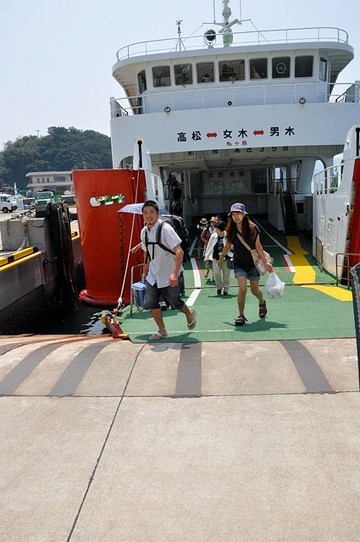
The Meon docking at Ogijima
Hotels near Takamatsu station enjoyed twice as many customers as usual and clientele expanded to include families, students and foreigners in addition to businessmen. Local and festival-related souvenir shops also did a brisk business.

Ogijima’s Soul by Jaume Plensa
Nothing is perfect however and a number of things need to be addressed before the next festival. For example, one of Art Setouchi’s greatest attractions was being forced to slow down to “island time”. Billed as an “art adventure”, exploring these out-of-the-way islands and ‘discovering’ art was really fun!! But once the word spread, the area was deluged with people.

Ferry line up at Inujima stretching off out of sight.
About 500,000 visitors descended on the festival in October alone, more than had come in the first 2 months combined! This stretched transportation, accommodation and art facilities to the limit. It was the hardworking volunteer staff, the islanders’ spirit of hospitality and the patience of visitors that carried the festival through this overload.

Helping each other out on Ogijima
While some locations reaped economic benefits from this huge influx of people, many local tourist attractions did not. For example, the number of visitors to my favorite Takamatsu spot, Ritsurin Garden, (see http://cathy.ashita-sanuki.jp/e229240.html ) dropped to 87% of the norm in August and to 63% in September, even though it’s very accessible. The festival seems to have caught many local organizations and businesses by surprise and they were too late to take advantage of the opportunity. If they are going to link up with the next festival, they need to be involved from the planning stage.
The real measure of the festival’s success, however, must be its impact on the islands and on us, a subject I will look at in my next article.
*Note:
The fact that many sites are still open has been very under-publicized. Fortunately, despite this, some people are going back, glad to be able to enjoy the remaining sites at their leisure. If you are visiting or live here, go and check them out.
Sites open through to the end of December 2010 are listed here (Japanese only):
http://setouchi-artfest.jp/images/uploads/misc/artworks_20101101_20101231r.pdf
Sites open January through to the end of March 2011 are listed here (Japanese only):
http://setouchi-artfest.jp/images/uploads/misc/artworks_20110101_20110131.pdf
* Many thanks to Kazumi, Hiroko, Reina, Kento and Pat for sharing photos for this and the next article.
The Setouchi International Art Festival was supposed to end on October 31. And it did, but it proved so successful that the prefecture has decided to go ahead with the original plan of hosting another festival in three years.
Jumping for joy on Megijima
In addition, many of the sites that were to be shut down and dismantled are being kept open for a few more months. A total of 42 sites* will be open, at least on weekends. Extra ferries and island buses will also be kept running experimentally to see if there is enough local demand to make their continuation worthwhile.
Seagull Parking Lot, Takahito Kimura, Megijima
So just how successful was it? In June, the organizers anticipated the festival would attract about 300,000 visitors with an economic benefit of about 5 billion yen. In fact, however, the festival attracted over 938, 000 visitors with an economic benefit of close to 15 billion yen. Wow!!!
Happy travelers on Teshima
The biggest financial winners were probably the ferry companies. Ferries were filled to capacity even with extra sailings to keep up with demand. Ferries to Megijima and Ogijima islands, for example, had 2.4 times more passengers than usual, causing the company to scrap its plans for selling off one of its boats.

The Meon docking at Ogijima
Hotels near Takamatsu station enjoyed twice as many customers as usual and clientele expanded to include families, students and foreigners in addition to businessmen. Local and festival-related souvenir shops also did a brisk business.
Ogijima’s Soul by Jaume Plensa
Nothing is perfect however and a number of things need to be addressed before the next festival. For example, one of Art Setouchi’s greatest attractions was being forced to slow down to “island time”. Billed as an “art adventure”, exploring these out-of-the-way islands and ‘discovering’ art was really fun!! But once the word spread, the area was deluged with people.

Ferry line up at Inujima stretching off out of sight.
About 500,000 visitors descended on the festival in October alone, more than had come in the first 2 months combined! This stretched transportation, accommodation and art facilities to the limit. It was the hardworking volunteer staff, the islanders’ spirit of hospitality and the patience of visitors that carried the festival through this overload.
Helping each other out on Ogijima
While some locations reaped economic benefits from this huge influx of people, many local tourist attractions did not. For example, the number of visitors to my favorite Takamatsu spot, Ritsurin Garden, (see http://cathy.ashita-sanuki.jp/e229240.html ) dropped to 87% of the norm in August and to 63% in September, even though it’s very accessible. The festival seems to have caught many local organizations and businesses by surprise and they were too late to take advantage of the opportunity. If they are going to link up with the next festival, they need to be involved from the planning stage.
The real measure of the festival’s success, however, must be its impact on the islands and on us, a subject I will look at in my next article.
*Note:
The fact that many sites are still open has been very under-publicized. Fortunately, despite this, some people are going back, glad to be able to enjoy the remaining sites at their leisure. If you are visiting or live here, go and check them out.
Sites open through to the end of December 2010 are listed here (Japanese only):
http://setouchi-artfest.jp/images/uploads/misc/artworks_20101101_20101231r.pdf
Sites open January through to the end of March 2011 are listed here (Japanese only):
http://setouchi-artfest.jp/images/uploads/misc/artworks_20110101_20110131.pdf
* Many thanks to Kazumi, Hiroko, Reina, Kento and Pat for sharing photos for this and the next article.
2011年12月10日
The Last Word
The Last Word On Setouchi Art Festival 2010
Curious about the festival’s impact on the islands and on people, I have been talking with local artists and friends involved in the festival as well as others like me who experienced it.

Seto Inland Sea
According to my sources, while many islanders warmly welcomed the visitors, they are now breathing a sigh of relief. The party is over and they are happy to return to the slower pace of “island time”.

Island time on Teshima
During the festival, particularly on weekends and through most of October, some villages were so crowded that local residents had difficulty just walking down the street to get home. And, unfortunately, some people left their garbage behind.
On the bright side, the islanders realized that people actually enjoyed coming to their islands. Left behind by mainstream society, their backwater villages are now on the brink of disappearing but the festival demonstrated that they do indeed have charm and potential. The question is where to go from here.
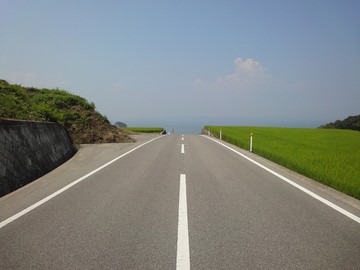
Teshima
If nothing else, Art Setouchi has forced those directly involved as well as those who just live here to ponder this very question. Further action, particularly by the islanders, is needed to explore the opportunities provided by the festival. Ideally, each island will develop their own style of collaboration with other people living in the prefecture as well as with artists – a collaboration that promotes sustainable action.

Lightening Shodoshima by Sense Art Studio
As a local and frequent visitor to the festival, I would have to say that it was nothing but positive. It gave me a chance to experience and appreciate the beauty of what we have. It also, as one friend aptly put it, served as a medium for people to make meaningful connections, with each other and with art and nature. What kept so many people going back? In their words…

Farther Memory by Chiharu Shiota
… art in architecture/architecture in art

Project by Aichi Prefectural University of Fine Arts and Music Team
… being able to walk right into an exhibit
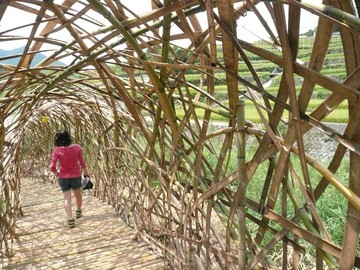
House of Shodoshima by Wang Wen-Chih
and enjoy it like this

inside
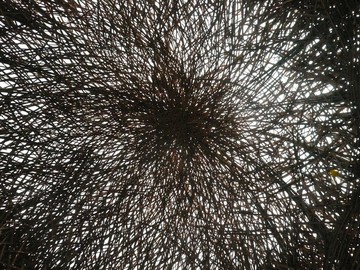
and out!

…art in nature/nature in art

When You Think of an Island by Rika Aki, Shodoshima
…having the time to listen
…to voices whispering through bamboo pipes

Voices from Disappeared People by Dadang Christanto, Shodoshima
…and seashells quivering by a spring.
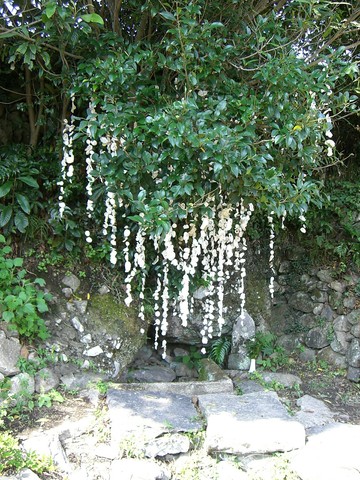
When You Think of an Island by Rika Aki, Shodoshima
… strange and wonderful encounters, such as walking through terraced rice fields in the middle of nowhere

and bumping into a friend from Tokyo.

Art within the ordinary made life extraordinary.

Hello Hachijuro by Hiroshi Fuji, Teshima

Ichigoya’s homemade strawberry sauce on ice, Teshima
And it was just so much fun!

For those of you who can, I hope you will consider going back to the islands on weekends and checking out the sites that are still open. The volunteers bravely manning the sites will be very glad to see you! If you don’t have a Japanese friend to read the schedules for you (See previous post), post a comment about where and when you want to go and I’ll let you know if it’s open.
For fans of Brazilian artist Oscar Oiwa
Oiwa Island, an amazing work drawn entirely with black magic markers and transformed into an endless landscape by mirrors, was sadly destroyed in a fire one month before the festival ended.
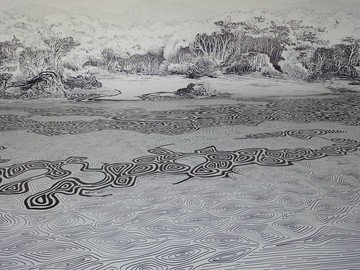
The work, however, has been awarded the festival’s grand prize. Many artists participated in the festival by invitation but some were chosen through a public screening process. Out of 721 entries, 20 artists were selected, and out of those, Oiwa’s Island won the prize. This grants the artist the right to participate in the next festival. We’ll look forward to seeing more of Oiwa’s work in Kagawa!
*Check out Oscar Oiwa’s site below to see a great video on the process of creating Oiwa’s Island.
http://www.oscaroiwastudio.com/oscar_website/pages.html/news.html
Video can also be accessed here: http://www.youtube.com/watch?v=zr59vzndrcU
Curious about the festival’s impact on the islands and on people, I have been talking with local artists and friends involved in the festival as well as others like me who experienced it.
Seto Inland Sea
According to my sources, while many islanders warmly welcomed the visitors, they are now breathing a sigh of relief. The party is over and they are happy to return to the slower pace of “island time”.
Island time on Teshima
During the festival, particularly on weekends and through most of October, some villages were so crowded that local residents had difficulty just walking down the street to get home. And, unfortunately, some people left their garbage behind.
On the bright side, the islanders realized that people actually enjoyed coming to their islands. Left behind by mainstream society, their backwater villages are now on the brink of disappearing but the festival demonstrated that they do indeed have charm and potential. The question is where to go from here.
Teshima
If nothing else, Art Setouchi has forced those directly involved as well as those who just live here to ponder this very question. Further action, particularly by the islanders, is needed to explore the opportunities provided by the festival. Ideally, each island will develop their own style of collaboration with other people living in the prefecture as well as with artists – a collaboration that promotes sustainable action.
Lightening Shodoshima by Sense Art Studio
As a local and frequent visitor to the festival, I would have to say that it was nothing but positive. It gave me a chance to experience and appreciate the beauty of what we have. It also, as one friend aptly put it, served as a medium for people to make meaningful connections, with each other and with art and nature. What kept so many people going back? In their words…
Farther Memory by Chiharu Shiota
… art in architecture/architecture in art
Project by Aichi Prefectural University of Fine Arts and Music Team
… being able to walk right into an exhibit
House of Shodoshima by Wang Wen-Chih
and enjoy it like this
inside
and out!
…art in nature/nature in art

When You Think of an Island by Rika Aki, Shodoshima
…having the time to listen
…to voices whispering through bamboo pipes
Voices from Disappeared People by Dadang Christanto, Shodoshima
…and seashells quivering by a spring.
When You Think of an Island by Rika Aki, Shodoshima
… strange and wonderful encounters, such as walking through terraced rice fields in the middle of nowhere
and bumping into a friend from Tokyo.
Art within the ordinary made life extraordinary.

Hello Hachijuro by Hiroshi Fuji, Teshima
Ichigoya’s homemade strawberry sauce on ice, Teshima
And it was just so much fun!
For those of you who can, I hope you will consider going back to the islands on weekends and checking out the sites that are still open. The volunteers bravely manning the sites will be very glad to see you! If you don’t have a Japanese friend to read the schedules for you (See previous post), post a comment about where and when you want to go and I’ll let you know if it’s open.
For fans of Brazilian artist Oscar Oiwa
Oiwa Island, an amazing work drawn entirely with black magic markers and transformed into an endless landscape by mirrors, was sadly destroyed in a fire one month before the festival ended.
The work, however, has been awarded the festival’s grand prize. Many artists participated in the festival by invitation but some were chosen through a public screening process. Out of 721 entries, 20 artists were selected, and out of those, Oiwa’s Island won the prize. This grants the artist the right to participate in the next festival. We’ll look forward to seeing more of Oiwa’s work in Kagawa!
*Check out Oscar Oiwa’s site below to see a great video on the process of creating Oiwa’s Island.
http://www.oscaroiwastudio.com/oscar_website/pages.html/news.html
Video can also be accessed here: http://www.youtube.com/watch?v=zr59vzndrcU
2011年03月28日
Ogijima Again!
In early March, shortly before our world turned upside down, my son, Kento, and I took a day trip to Ogijima. This island has always been one of my favorites and it was one Kento had missed seeing during the Setouchi Art Festival.

I was expecting the island to be back to its pre-art festival state – beautiful, of course, but not crowded. To my surprise, the boat was packed and extra ferries were scheduled.

March, it turns out, is narcissus season and as the tip of the island is planted with thousands of them, Ogijima hosts a very popular hiking event at this time. It was actually heartening to see that the island has a good fan following among local Kagawans, art or no art. There were booths selling local produce and a crowd of people enjoying delicious local cuisine outdoors in the lovely sunshine.


We opted to avoid the flow of people to the narcissus fields and turned into the village, following our original plan to visit the remaining art sites. This turned out to be a wise choice as we had them almost entirely to ourselves!!
To my delight, I found that the outdoor Wallalley works are weathering well and fusing with their surroundings.


At Kawashima and Dream Friends, the number of Memory Drops, particularly those made by visitors, had greatly increased so that it felt as if we were entering a multicolored galaxy.


A galaxy inhabited by beetles perhaps.

At SEA VINE, a ceramic wave of flowers that pours through a window facing the sea, I learned that each porcelain piece is painted with a detailed scene from the Seto Inland Sea.

What painstaking work!

I had never noticed this on any other visit. It helped that the volunteers had time for a leisurely chat. Not only did we find out interesting bits of information like this but we also got to share our love for art and the islands. This love of art seems to be catching, as we discovered little bits of art all around the town.


In addition to the lacquer project, Maison de Urushi, which was just as beautiful as I remembered, we dropped by Onba Factory to visit with our friend, Yoshifumi Oshima.


Onba Factory has produced about 60 artful strollers to date and they are being used by local people all over the village now. We saw two on the ferry as well, not to mention this one at Dream Friends that blends right in to the art installation.

Onba Factory for me best captures the spirit and purpose of the Art Festival. Oshima is committed for the long term and he is working with the local people to find ways to revitalize the island by bringing in new and younger blood. Without children, he says, the island has no future; without new blood, it will be an island of cats within ten years. The spark lit by the art festival, however, is still burning. There are signs that the islanders are taking more initiative. In January, they held a very successful onba market in cooperation with the Oshimas. Villagers filled 10 onba with local products and lined them up as shops in Onba Factory. The goods were sold out within two hours.

Having caught up with the art festival, Kento and I rounded out our visit by hiking down to the lighthouse and the narcissus field. It takes only 20 to 30 minutes one way and the views are fabulous. There is a mountain trail as well, which takes longer. Although we did not take it, we met many along the way who had and although they looked tired, they also looked very happy.

Kento and I have made a date to go for a picnic in April or May, or maybe both. This island is very therapeutic and we certainly need that right now.



ANNOUNCEMENT:
ART SETOUCHI has planned a series of events for spring on different islands. The series was launched with Music Parade, an open air concert of musicians and street performers, at Sunport Takamatsu on March 27. Planned some time ago, Music Parade was transformed into a charity event after the earthquake/tsunami occurred. The opening of a new work by video artist Pipilotti Rist on Teshima is scheduled for April 9. Various other events are planned on weekends and national holidays until May 8.
House of Shodoshima
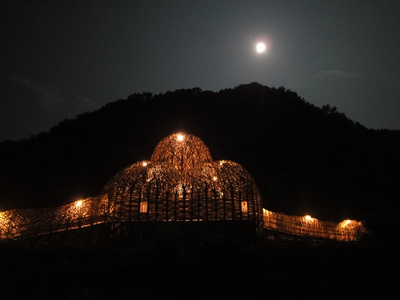

I was expecting the island to be back to its pre-art festival state – beautiful, of course, but not crowded. To my surprise, the boat was packed and extra ferries were scheduled.

March, it turns out, is narcissus season and as the tip of the island is planted with thousands of them, Ogijima hosts a very popular hiking event at this time. It was actually heartening to see that the island has a good fan following among local Kagawans, art or no art. There were booths selling local produce and a crowd of people enjoying delicious local cuisine outdoors in the lovely sunshine.


We opted to avoid the flow of people to the narcissus fields and turned into the village, following our original plan to visit the remaining art sites. This turned out to be a wise choice as we had them almost entirely to ourselves!!
To my delight, I found that the outdoor Wallalley works are weathering well and fusing with their surroundings.


At Kawashima and Dream Friends, the number of Memory Drops, particularly those made by visitors, had greatly increased so that it felt as if we were entering a multicolored galaxy.


A galaxy inhabited by beetles perhaps.

At SEA VINE, a ceramic wave of flowers that pours through a window facing the sea, I learned that each porcelain piece is painted with a detailed scene from the Seto Inland Sea.

What painstaking work!

I had never noticed this on any other visit. It helped that the volunteers had time for a leisurely chat. Not only did we find out interesting bits of information like this but we also got to share our love for art and the islands. This love of art seems to be catching, as we discovered little bits of art all around the town.


In addition to the lacquer project, Maison de Urushi, which was just as beautiful as I remembered, we dropped by Onba Factory to visit with our friend, Yoshifumi Oshima.


Onba Factory has produced about 60 artful strollers to date and they are being used by local people all over the village now. We saw two on the ferry as well, not to mention this one at Dream Friends that blends right in to the art installation.

Onba Factory for me best captures the spirit and purpose of the Art Festival. Oshima is committed for the long term and he is working with the local people to find ways to revitalize the island by bringing in new and younger blood. Without children, he says, the island has no future; without new blood, it will be an island of cats within ten years. The spark lit by the art festival, however, is still burning. There are signs that the islanders are taking more initiative. In January, they held a very successful onba market in cooperation with the Oshimas. Villagers filled 10 onba with local products and lined them up as shops in Onba Factory. The goods were sold out within two hours.

Having caught up with the art festival, Kento and I rounded out our visit by hiking down to the lighthouse and the narcissus field. It takes only 20 to 30 minutes one way and the views are fabulous. There is a mountain trail as well, which takes longer. Although we did not take it, we met many along the way who had and although they looked tired, they also looked very happy.

Kento and I have made a date to go for a picnic in April or May, or maybe both. This island is very therapeutic and we certainly need that right now.



ANNOUNCEMENT:
ART SETOUCHI has planned a series of events for spring on different islands. The series was launched with Music Parade, an open air concert of musicians and street performers, at Sunport Takamatsu on March 27. Planned some time ago, Music Parade was transformed into a charity event after the earthquake/tsunami occurred. The opening of a new work by video artist Pipilotti Rist on Teshima is scheduled for April 9. Various other events are planned on weekends and national holidays until May 8.
House of Shodoshima

2011年02月15日
Art on Honjima

Heading for Honjima
I was off island tripping again recently – this time to Honjima. This island is part of the Shiwaku archipelago, which has played a key role in Japanese maritime transport since ancient times. The currents and shoals around these islands make navigation extremely tricky.

Sunset on the straits off Honjima
Not surprisingly, the people who lived here were expert seamen and navigators. Known as the Shiwaku pirates, they ruled traffic on the Inland Sea. Rather than being in conflict with the authorities, however, they made profitable agreements with them, ferrying goods and granting safe passage. When Japan closed itself to the outside world at the beginning of the 17th century, the ruling Tokugawa shogunate did not maintain its own navy. Instead, they relied on the Shiwaku seamen to provide both shipping and maritime protection. In return, the Shiwaku islanders received full autonomy over their own affairs and were exempt from taxation. When the country was reopened in the mid-19th century, these skilled navigators and sailors also comprised the majority of the crews that sailed the first Japanese ships to America and Europe.

street in Honjima
Honjima (which means “main island”) was the political and economic center of the archipelago and the island retains many historical and cultural assets. Plenty of them are architectural because the island’s shipbuilders doubled as skilled carpenters.

Storehouse (kura) on Honjima

Closeup
When the demand for ships declined after the Meiji era, these carpenters left the island to seek work elsewhere. Consequently, the best shrines and temples constructed in the Shikoku-Chugoku region during this period, as well as the storehouses and merchant buildings in Kurashiki (for which it is now famous), were built by Shiwaku carpenters.

Old clay wall with used roof tiles embedded as fireproofing

storehouse (kura) not yet restored
Fortunately, over 100 exquisite Edo and Meiji period buildings have also been preserved right on Honjima in the Kasashima district. This was my destination and my purpose was to help set up an art exhibit at the Gallery Arte.

Gallery Arte exterior

Interior
Like the other islands in the Seto Inland Sea, Honjima has suffered drastic depopulation. The gallery director, Ikuyo Umetani, relocated here in 2009 with the goal of creating a focal point to draw new people to the aging island and revitalize the community.

Frequent Gallery Arte visitor
Umetani-san has been inviting artists from different parts of Japan to stay and create works for display and sale. While there, the artists also interact with the local community, giving workshops at the school and kindergarten and sharing meals with local residents. (The gallery is also a café serving simple lunches, coffee and wine.)
The exhibit running from February through to March 27, 2011 is called Shining Daikon, Sparkling Cabbage and consists of vegetables that light up from within as the viewer walks past. It’s a bit hard to describe but maybe you can get the idea from these photos.
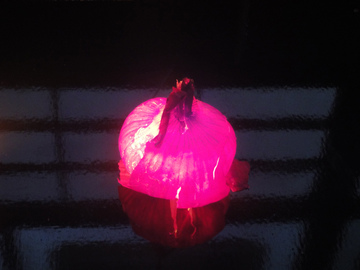
Onion

Cabbage

Leeks

Garlic

If you are an artist and are interested in the artist-in-residence program, check out the following site. The English site hasn’t been updated since last year, but the program is ongoing.
http://en.air-j.info/result/center_37202/
Access Details:
From Shikoku, you can get to Honjima by ferry from Marugame city (30 minutes from Takamatsu by JR train on the Yosan line). The port is under 10 minutes walk from Marugame station. The ferry takes 35 minutes and costs 1,010 yen round trip. (See timetable below provided courtesy of TIA-INFO. If you are coming from Honshu, a ferry leaves from Kojima in Okayama.) Gallery Arte and the historical district are about 10 minutes from Honjima’s port by bicycle, which can be rented when you arrive, and about 20 minutes on foot. Be sure to drop into Kinbansho about halfway to the historical district. This is the former center of island government. It’s a great building and contains such artifacts as 16th century documents bearing the official seal of Oda Nobunaga and Tokugawa Ieyasu.

Kinbansho
Gallery ARTE
Hours: 11:30-16:30 Closed on Mon. and Tue. (Open if those days are holidays)
Admission: Free
Exhibit: Feb.2-Mar. 27, 2011, “Shining Daikon, Sparkling Cabbage” - Yuichi Hirano
Café
Kimagure lunch from JPY 600 to JPY 750.
Pasta/pizza JPY1000.
Kanrinmaru lunch JPY1,500 (reservation required for this particular meal but not for others).
Address:
305 Kasajima Honjima, Marugame-shi, Kagawa
Tel: 0877-57-8255 / e-mail: arte@mti.biglobe.ne.jp
Web: http://www5a.biglobe.ne.jp/~Arte2000/index.html

2011年01月26日
New Year’s Traditions
Japanese New Year’s and Christmas are very different holidays. Yet some things about the two seem surprisingly similar.
Christmas as celebrated by my Canadian family is a time for reconnecting with family and friends through Christmas cards. In Japan, we do the same but with New Year’s cards. Here is the bundle we received on New Year’s Day.

Many are just store bought but some are personally designed and even handmade like the selection below. As you can see by the pictures, 2011 is the year of the rabbit.

Christmas in Canada as I remember it, is a time spent celebrating the joy of being together, free from the busyness of everyday life. Japanese New Year’s is the same. Everyone heads “home” to be with family and the mass of humanity leaving the big cities clogs up the transportation system for several days. We were happy to have our two city dwelling kids join us from Tokyo.

Christmas and New Year’s are both religious festivals. In Japan, the New Year is welcomed in by tolling the temple bell at midnight on December 31. The bell is tolled once for each of 108 worldly passions to wipe the slate clean for the coming year. This is followed over the next few days by a trip to a shrine (or 2 or 3) to pray for good fortune. The lineup of people at Tamura Shrine went all the way out the gate and down the street. Obviously, this is still a popular custom.

Lining up to pray (photo from Jan. 2010)

Finally, both Christmas and Japanese New Year’s mean food and hospitality and the traditional foods, while very different, are prepared with the same concept in mind – to feed a large number of people for some time and free the cook from the kitchen. I remember preparing sweets weeks before Christmas and storing them in the pantry to serve visitors during the Christmas season. While the turkey was made on Christmas Day, it also seemed to last for at least a week, reappearing as soup or sandwiches.
Japanese traditional New Year’s foods likewise are made ahead and made to last. One of these is mochi, glutinous rice cooked, pummeled and molded into cakes. A friend kindly invited us to join their family’s annual mochi-making gathering. The process is labor intensive and therefore everyone took turns pounding and shaping. Here is the rice being steamed,

pounded in a stone mortar

and hand shaped by a pro.

The result is a colorful array of mochi in black bean, dried shrimp, seaweed and plain flavors that last at least a month when they have dried.

Much of the pounded rice, however, was consumed while still hot before it even had the chance to become mochi. Various fillings and sauces included bean paste, grated daikon and soy sauce, soy sauce and sugar, strawberries and chocolate almonds. Mmmmm!! Delicious.
This is what mochi looked like on New Year’s Day in the traditional New Year’s soup called zoni.

The contents of zoni and the way the mochi are eaten differ from one area to another. In Takamatsu, zoni is made with sweet, white miso and the mochi are filled with bean paste. This custom appears to be unique to the Kagawa region and often grosses out people from other areas who haven’t tried it. It’s actually quite tasty.

My mother-in-law, however, is from Osaka, near Nara, so our family’s tradition has been passed down from her. The soup is still white miso, but the mochi are allowed to dissolve into a gluey mess, then removed from the soup and coated with soybean flour and sugar. It tastes far better than it looks!

I hope you all enjoyed your own special family traditions this holiday. Best wishes for 2011.
Christmas as celebrated by my Canadian family is a time for reconnecting with family and friends through Christmas cards. In Japan, we do the same but with New Year’s cards. Here is the bundle we received on New Year’s Day.
Many are just store bought but some are personally designed and even handmade like the selection below. As you can see by the pictures, 2011 is the year of the rabbit.
Christmas in Canada as I remember it, is a time spent celebrating the joy of being together, free from the busyness of everyday life. Japanese New Year’s is the same. Everyone heads “home” to be with family and the mass of humanity leaving the big cities clogs up the transportation system for several days. We were happy to have our two city dwelling kids join us from Tokyo.
Christmas and New Year’s are both religious festivals. In Japan, the New Year is welcomed in by tolling the temple bell at midnight on December 31. The bell is tolled once for each of 108 worldly passions to wipe the slate clean for the coming year. This is followed over the next few days by a trip to a shrine (or 2 or 3) to pray for good fortune. The lineup of people at Tamura Shrine went all the way out the gate and down the street. Obviously, this is still a popular custom.

Lining up to pray (photo from Jan. 2010)

Finally, both Christmas and Japanese New Year’s mean food and hospitality and the traditional foods, while very different, are prepared with the same concept in mind – to feed a large number of people for some time and free the cook from the kitchen. I remember preparing sweets weeks before Christmas and storing them in the pantry to serve visitors during the Christmas season. While the turkey was made on Christmas Day, it also seemed to last for at least a week, reappearing as soup or sandwiches.
Japanese traditional New Year’s foods likewise are made ahead and made to last. One of these is mochi, glutinous rice cooked, pummeled and molded into cakes. A friend kindly invited us to join their family’s annual mochi-making gathering. The process is labor intensive and therefore everyone took turns pounding and shaping. Here is the rice being steamed,
pounded in a stone mortar
and hand shaped by a pro.
The result is a colorful array of mochi in black bean, dried shrimp, seaweed and plain flavors that last at least a month when they have dried.
Much of the pounded rice, however, was consumed while still hot before it even had the chance to become mochi. Various fillings and sauces included bean paste, grated daikon and soy sauce, soy sauce and sugar, strawberries and chocolate almonds. Mmmmm!! Delicious.
This is what mochi looked like on New Year’s Day in the traditional New Year’s soup called zoni.
The contents of zoni and the way the mochi are eaten differ from one area to another. In Takamatsu, zoni is made with sweet, white miso and the mochi are filled with bean paste. This custom appears to be unique to the Kagawa region and often grosses out people from other areas who haven’t tried it. It’s actually quite tasty.
My mother-in-law, however, is from Osaka, near Nara, so our family’s tradition has been passed down from her. The soup is still white miso, but the mochi are allowed to dissolve into a gluey mess, then removed from the soup and coated with soybean flour and sugar. It tastes far better than it looks!
I hope you all enjoyed your own special family traditions this holiday. Best wishes for 2011.
2011年01月14日
Happy New Year!
For me, it was a very happy New Year. We had the kids home and did traditional Japanese New Year’s things, such as… waking up at 6 AM to watch the first sunrise of the New Year.
Or, at least, my husband and I did. The kids actually stayed up all night and kindly (?) woke us up to join them. Considering that we had already stayed up until 2:00 AM writing (late) New Year’s cards and doing other traditional things, this was a bit painful but still we dragged ourselves from our nice warm futon and headed for Mt. Yashima. (At less than 300 meters in height, this is actually a hill by Canadian standards.)

Mt. Yashima as seen from our house.
To be really true to tradition, we should have made the steep 30-minute climb on foot and many people still do. As this was our first time, however, we chose the easy way – a 5-minute car ride up Yashima driveway. To my surprise, there was actually a lineup at the tollgate and the parking lot at the top was getting quite full even at 6:30 AM. Many people had also staked out choice viewing spots along the driveway. It finally dawned on me that seeing the first sunrise of the year is a popular event! There must have been at least 400 people on Yashima alone, and there are plenty of other good viewing spots in the city that probably had their own crowds.
Once at the top, the booming of Wadaiko (Japanese drums) led us to the viewing site.
Drummers and spectators greeting the sun

Crowd waiting

There is something primeval about walking through the dim pre-dawn light on a mountaintop, accompanied by the deep rolling thunder of drums, and then merging with an anonymous crowd of people all gazing expectantly towards the horizon.
Brave drummers sleeveless despite sub-zero temperatures.

The sun slowly but surely showed its face, welcomed by a cheering crowd and the clicking of camera and cell phone shutters.
Great panorama of the Seto Inland Sea from this spot

Here comes the sun!





This tradition is called Hatsu-hinode, meaning “first sunrise”. All “firsts” in the New Year are awarded special attention in Japanese culture and each important action is given the character 初(“hatsu” or “hajime”) when you do it for the first time in the New Year. Such as “hatsumode”, the first trip to pray at a shrine or temple. Once the sun was up, that’s exactly where the crowd of sun spectators headed – to pray for the coming year at Yashimaji, a temple with a shrine beside it.
Crowd pouring through the temple gate

And heading for the temple


We, however, went home for breakfast!
View on the way down

Yashima Access: If you want to see the sunrise, you’ll need to go by car or on foot. If you want to sightsee during the day, the train and shuttle bus are also options. Please note that the shuttle bus does not run from Dec. to Feb. except on January 1, 2, and 3 and the earliest bus is after 8:00 AM.
By car: From downtown Takamatsu, take Route 11 east towards Tokushima and turn left at the MacDonald’s that is on the left side of the road. Yashima Driveway runs up the hill past Shikoku Mura. The toll for passenger cars is 610 yen. The parking lot at the top has 400 parking spots.
On foot: It takes about 30 minutes to walk up the hill and it’s quite steep. The hiking trail starts on the east side of Yashima Elementary School, which is not on a bus or train route. I recommend biking there if you live within decent biking distance. The trail can also be reached on foot from Kotoden Yashima station, which adds an extra 10 to 20 minutes to your hike. You will need to ask someone who knows the area to give you directions to the trail.
By Kotoden train: take a train from Takamatsu-Chikko Station to Kawaramachi Station (4 minutes, frequent departures) and transfer to the Shido Line. Get off at Kotoden Yashima Station (13 minutes, 3 trains/hour). The entire trip takes about 20 minutes and costs 310 yen. Sanjo Shuttle bus runs once per hour to the summit (10 minutes, 100 yen).
By JR train: take a local train from JR Takamatsu Station traveling in the Tokushima direction. Get off at Yashima Station (15 minutes, 210 yen, 2 trains/hour). From the station the Yashima Sanjo Shuttle bus runs once per hour to the summit (20 minutes, 100 yen).
Or, at least, my husband and I did. The kids actually stayed up all night and kindly (?) woke us up to join them. Considering that we had already stayed up until 2:00 AM writing (late) New Year’s cards and doing other traditional things, this was a bit painful but still we dragged ourselves from our nice warm futon and headed for Mt. Yashima. (At less than 300 meters in height, this is actually a hill by Canadian standards.)
Mt. Yashima as seen from our house.
To be really true to tradition, we should have made the steep 30-minute climb on foot and many people still do. As this was our first time, however, we chose the easy way – a 5-minute car ride up Yashima driveway. To my surprise, there was actually a lineup at the tollgate and the parking lot at the top was getting quite full even at 6:30 AM. Many people had also staked out choice viewing spots along the driveway. It finally dawned on me that seeing the first sunrise of the year is a popular event! There must have been at least 400 people on Yashima alone, and there are plenty of other good viewing spots in the city that probably had their own crowds.
Once at the top, the booming of Wadaiko (Japanese drums) led us to the viewing site.
Drummers and spectators greeting the sun
Crowd waiting
There is something primeval about walking through the dim pre-dawn light on a mountaintop, accompanied by the deep rolling thunder of drums, and then merging with an anonymous crowd of people all gazing expectantly towards the horizon.
Brave drummers sleeveless despite sub-zero temperatures.
The sun slowly but surely showed its face, welcomed by a cheering crowd and the clicking of camera and cell phone shutters.
Great panorama of the Seto Inland Sea from this spot
Here comes the sun!
This tradition is called Hatsu-hinode, meaning “first sunrise”. All “firsts” in the New Year are awarded special attention in Japanese culture and each important action is given the character 初(“hatsu” or “hajime”) when you do it for the first time in the New Year. Such as “hatsumode”, the first trip to pray at a shrine or temple. Once the sun was up, that’s exactly where the crowd of sun spectators headed – to pray for the coming year at Yashimaji, a temple with a shrine beside it.
Crowd pouring through the temple gate
And heading for the temple
We, however, went home for breakfast!
View on the way down
Yashima Access: If you want to see the sunrise, you’ll need to go by car or on foot. If you want to sightsee during the day, the train and shuttle bus are also options. Please note that the shuttle bus does not run from Dec. to Feb. except on January 1, 2, and 3 and the earliest bus is after 8:00 AM.
By car: From downtown Takamatsu, take Route 11 east towards Tokushima and turn left at the MacDonald’s that is on the left side of the road. Yashima Driveway runs up the hill past Shikoku Mura. The toll for passenger cars is 610 yen. The parking lot at the top has 400 parking spots.
On foot: It takes about 30 minutes to walk up the hill and it’s quite steep. The hiking trail starts on the east side of Yashima Elementary School, which is not on a bus or train route. I recommend biking there if you live within decent biking distance. The trail can also be reached on foot from Kotoden Yashima station, which adds an extra 10 to 20 minutes to your hike. You will need to ask someone who knows the area to give you directions to the trail.
By Kotoden train: take a train from Takamatsu-Chikko Station to Kawaramachi Station (4 minutes, frequent departures) and transfer to the Shido Line. Get off at Kotoden Yashima Station (13 minutes, 3 trains/hour). The entire trip takes about 20 minutes and costs 310 yen. Sanjo Shuttle bus runs once per hour to the summit (10 minutes, 100 yen).
By JR train: take a local train from JR Takamatsu Station traveling in the Tokushima direction. Get off at Yashima Station (15 minutes, 210 yen, 2 trains/hour). From the station the Yashima Sanjo Shuttle bus runs once per hour to the summit (20 minutes, 100 yen).
2010年12月30日
‘Art-full’ Dining Tokiwa Saryo
Here’s another gem hidden away in the central Takamatsu: Japanese restaurant Tokiwa Saryo.

Tokiwa Saryo Restaurant
Located just one street south of the Tokiwa-gai arcade, this restaurant is closely connected to the shopping district’s history. It was built in the early 1950s by Jukichi Mizobuchi, a prominent local producer involved in theater, movies and events. Mizobuchi had already built a theater nearby, stimulating the development of a shopping arcade in this area.

Entrance
Tokiwa Saryo started out as a very posh inn. The design was so elaborate that construction took 4 years to complete. The distinctive golden fish and blue tiles that topped the castle-like structure could be seen all the way from Takamatsu Station when it was first built and it numbered among its clientele many famous people from showbiz, commerce and politics.
Due to modern fire regulations, the top floors are no longer used as a hotel, but the bottom two floors have been converted into a spectacular restaurant replete with inner courtyard garden and pond.

Dining area viewed from the courtyard.
The restaurant serves Japanese style box lunches with a little bit of everything, or tempura and sashimi set lunches. Prices are very reasonable ranging from a little over 1,000 to 3,000 yen for lunch. The food is delicious but even if it were ordinary, I think the price is still worth it just for the décor.
After lunch, you can ask for permission to take a stroll through the courtyard and beyond.

Courtyard

Alcove

The garden

The bridge

Looking back towards the dining area
The most stunning part of this restaurant, however, is the hall down a corridor to the left after crossing the little red bridge. Built in imitation of the drawing room of Nijo Castle in Kyoto, the walls and ceiling of the hall are covered with lacquer works by Akashi Bokkei, a local lacquer craftsman of the time.

Wall mural – pine tree
Bokkei’s wall mural motif consists of pine, bamboo and plum blossoms, which are symbols of celebration and good fortune in Japan.

Plum blossoms
Butterflies weave among the pine and plum trees, one for each year of Mizobuchi’s life. He passed away before the work was completed.

Bamboo
The cabinet in the above photo was custom made to house what was, at the time, a very modern stereo and speaker complete with LP records.

Ceiling
If you do find this room, don’t forget to look up. The ceiling panels are also elaborate lacquer work and mimic those found in castles and temples.

Ceiling panel close up
And last but not least are the koi (carp), another auspicious symbol, made by yet another skilled local artist of that period, Hidari Kohkyo.

Koi
If you are with a large group, you can reserve this room for lunch or dinner. If you are not with a large group but want to see the room, ask for permission at the front desk. They will usually let you wander in and take pictures, as long as you are quiet and respectful (i.e. keep out of the way of restaurant staff and guests).
Directions: From the west side of Kotoden Kawaramachi Station head down the covered shopping arcade called Tokiwa-gai. Turn left at a side street with a green grocer’s on the near corner and a lantern high up on the wall on the far side. (See the photo below.) The lantern says “Tokiwa Saryo” on it in Japanese.
写真15
Turn left at this corner.
Tokiwa Saryo is at the corner of the next street on the right. There’s also a map (in Japanese) on the website below.
Times: Lunch 11:00 to 15:00
Dinner: 17:00 to 22:00 (prices are higher for dinner)
Tel: 087-861-5577
Website: http://www.trs1515.com/~saryou/inquiry/top.html
For a little more information in English on prices, etc., see:
http://www.frommers.com/destinations/takamatsu/D50552.html
Tokiwa Saryo Restaurant
Located just one street south of the Tokiwa-gai arcade, this restaurant is closely connected to the shopping district’s history. It was built in the early 1950s by Jukichi Mizobuchi, a prominent local producer involved in theater, movies and events. Mizobuchi had already built a theater nearby, stimulating the development of a shopping arcade in this area.
Entrance
Tokiwa Saryo started out as a very posh inn. The design was so elaborate that construction took 4 years to complete. The distinctive golden fish and blue tiles that topped the castle-like structure could be seen all the way from Takamatsu Station when it was first built and it numbered among its clientele many famous people from showbiz, commerce and politics.
Due to modern fire regulations, the top floors are no longer used as a hotel, but the bottom two floors have been converted into a spectacular restaurant replete with inner courtyard garden and pond.
Dining area viewed from the courtyard.
The restaurant serves Japanese style box lunches with a little bit of everything, or tempura and sashimi set lunches. Prices are very reasonable ranging from a little over 1,000 to 3,000 yen for lunch. The food is delicious but even if it were ordinary, I think the price is still worth it just for the décor.
After lunch, you can ask for permission to take a stroll through the courtyard and beyond.
Courtyard
Alcove
The garden
The bridge
Looking back towards the dining area
The most stunning part of this restaurant, however, is the hall down a corridor to the left after crossing the little red bridge. Built in imitation of the drawing room of Nijo Castle in Kyoto, the walls and ceiling of the hall are covered with lacquer works by Akashi Bokkei, a local lacquer craftsman of the time.
Wall mural – pine tree
Bokkei’s wall mural motif consists of pine, bamboo and plum blossoms, which are symbols of celebration and good fortune in Japan.
Plum blossoms
Butterflies weave among the pine and plum trees, one for each year of Mizobuchi’s life. He passed away before the work was completed.
Bamboo
The cabinet in the above photo was custom made to house what was, at the time, a very modern stereo and speaker complete with LP records.
Ceiling
If you do find this room, don’t forget to look up. The ceiling panels are also elaborate lacquer work and mimic those found in castles and temples.
Ceiling panel close up
And last but not least are the koi (carp), another auspicious symbol, made by yet another skilled local artist of that period, Hidari Kohkyo.
Koi
If you are with a large group, you can reserve this room for lunch or dinner. If you are not with a large group but want to see the room, ask for permission at the front desk. They will usually let you wander in and take pictures, as long as you are quiet and respectful (i.e. keep out of the way of restaurant staff and guests).
Directions: From the west side of Kotoden Kawaramachi Station head down the covered shopping arcade called Tokiwa-gai. Turn left at a side street with a green grocer’s on the near corner and a lantern high up on the wall on the far side. (See the photo below.) The lantern says “Tokiwa Saryo” on it in Japanese.
写真15
Turn left at this corner.
Tokiwa Saryo is at the corner of the next street on the right. There’s also a map (in Japanese) on the website below.
Times: Lunch 11:00 to 15:00
Dinner: 17:00 to 22:00 (prices are higher for dinner)
Tel: 087-861-5577
Website: http://www.trs1515.com/~saryou/inquiry/top.html
For a little more information in English on prices, etc., see:
http://www.frommers.com/destinations/takamatsu/D50552.html
2010年12月16日
Post-Art Setouchi Schedules
Some great news for any of you interested in visiting the Art Setouchi island sites that are still open. David and his wife have kindly translated the schedules for the different sites into English. You can find them at the bottom of this article at David’s blog.
http://ogijima.com/2010/11/26/the-setouchi-international-art-festival-2010-has-ended-or-has-it/
As David mentions, there are still some Sealight sculptures around town. I’ve seen a couple hanging in the shopping arcade for example. See if you can find the giant glowing squid hanging from the arcade roof in the photo below. It’s between the 2nd and 3rd yellow arch in the roof.

In addition, the Gentle Art Project on Oshima finally posted its schedule for the next 4 months. It will be open Dec. 17-19, Jan. 15-16, Feb. 11-13, Mar. 12-13. Boats leave Takamatsu port at 9:10, 11:00 and 13:55. You do not need a ticket but you need to identify yourself to the Koyubikai staff when you reach Oshima. Boats returning to Takamatsu leave at 10:30, 13:25 and 16:15. The café, which serves light meals, sweets and drinks, and Gallery 15 will be open. If you go on a later boat, however, the café will probably be out of food.
Finally, Onba Factory and Kawashima and Dream Friends got together and put up Christmas light displays on Ogijima to bring some cheer to the islanders. There’s even an illuminated wreath on the Meon ferry. The displays will be lit up until the end of Dec. 25. Lights go on at 17:00 and they’ve put on an evening ferry to bring viewers back, leaving Ogijima at 19:00 PM every day until Dec. 26.
(Photos and information courtesy of the Setouchi Art Festival website.)
http://ogijima.com/2010/11/26/the-setouchi-international-art-festival-2010-has-ended-or-has-it/
As David mentions, there are still some Sealight sculptures around town. I’ve seen a couple hanging in the shopping arcade for example. See if you can find the giant glowing squid hanging from the arcade roof in the photo below. It’s between the 2nd and 3rd yellow arch in the roof.
In addition, the Gentle Art Project on Oshima finally posted its schedule for the next 4 months. It will be open Dec. 17-19, Jan. 15-16, Feb. 11-13, Mar. 12-13. Boats leave Takamatsu port at 9:10, 11:00 and 13:55. You do not need a ticket but you need to identify yourself to the Koyubikai staff when you reach Oshima. Boats returning to Takamatsu leave at 10:30, 13:25 and 16:15. The café, which serves light meals, sweets and drinks, and Gallery 15 will be open. If you go on a later boat, however, the café will probably be out of food.
Finally, Onba Factory and Kawashima and Dream Friends got together and put up Christmas light displays on Ogijima to bring some cheer to the islanders. There’s even an illuminated wreath on the Meon ferry. The displays will be lit up until the end of Dec. 25. Lights go on at 17:00 and they’ve put on an evening ferry to bring viewers back, leaving Ogijima at 19:00 PM every day until Dec. 26.
(Photos and information courtesy of the Setouchi Art Festival website.)
2010年11月25日
The Last Word
The Last Word On Setouchi Art Festival 2010
Curious about the festival’s impact on the islands and on people, I have been talking with local artists and friends involved in the festival as well as others like me who experienced it.

Seto Inland Sea
According to my sources, while many islanders warmly welcomed the visitors, they are now breathing a sigh of relief. The party is over and they are happy to return to the slower pace of “island time”.

Island time on Teshima
During the festival, particularly on weekends and through most of October, some villages were so crowded that local residents had difficulty just walking down the street to get home. And, unfortunately, some people left their garbage behind.
On the bright side, the islanders realized that people actually enjoyed coming to their islands. Left behind by mainstream society, their backwater villages are now on the brink of disappearing but the festival demonstrated that they do indeed have charm and potential. The question is where to go from here.

Teshima
If nothing else, Art Setouchi has forced those directly involved as well as those who just live here to ponder this very question. Further action, particularly by the islanders, is needed to explore the opportunities provided by the festival. Ideally, each island will develop their own style of collaboration with other people living in the prefecture as well as with artists – a collaboration that promotes sustainable action.

Lightening Shodoshima by Sense Art Studio
As a local and frequent visitor to the festival, I would have to say that it was nothing but positive. It gave me a chance to experience and appreciate the beauty of what we have. It also, as one friend aptly put it, served as a medium for people to make meaningful connections, with each other and with art and nature. What kept so many people going back? In their words…

Farther Memory by Chiharu Shiota
… art in architecture/architecture in art

Project by Aichi Prefectural University of Fine Arts and Music Team
… being able to walk right into an exhibit

House of Shodoshima by Wang Wen-Chih
and enjoy it like this

inside

and out!

…art in nature/nature in art

When You Think of an Island by Rika Aki, Shodoshima
…having the time to listen
…to voices whispering through bamboo pipes

Voices from Disappeared People by Dadang Christanto, Shodoshima
…and seashells quivering by a spring.

When You Think of an Island by Rika Aki, Shodoshima
… strange and wonderful encounters, such as walking through terraced rice fields in the middle of nowhere

and bumping into a friend from Tokyo.

Art within the ordinary made life extraordinary.

Hello Hachijuro by Hiroshi Fuji, Teshima

Ichigoya’s homemade strawberry sauce on ice, Teshima
And it was just so much fun!

For those of you who can, I hope you will consider going back to the islands on weekends and checking out the sites that are still open. The volunteers bravely manning the sites will be very glad to see you! If you don’t have a Japanese friend to read the schedules for you (See previous post), post a comment about where and when you want to go and I’ll let you know if it’s open.
For fans of Brazilian artist Oscar Oiwa
Oiwa Island, an amazing work drawn entirely with black magic markers and transformed into an endless landscape by mirrors, was sadly destroyed in a fire one month before the festival ended.

The work, however, has been awarded the festival’s grand prize. Many artists participated in the festival by invitation but some were chosen through a public screening process. Out of 721 entries, 20 artists were selected, and out of those, Oiwa’s Island won the prize. This grants the artist the right to participate in the next festival. We’ll look forward to seeing more of Oiwa’s work in Kagawa!
*Check out Oscar Oiwa’s site below to see a great video on the process of creating Oiwa’s Island.
http://www.oscaroiwastudio.com/oscar_website/pages.html/news.html
Video can also be accessed here: http://www.youtube.com/watch?v=zr59vzndrcU
Curious about the festival’s impact on the islands and on people, I have been talking with local artists and friends involved in the festival as well as others like me who experienced it.
Seto Inland Sea
According to my sources, while many islanders warmly welcomed the visitors, they are now breathing a sigh of relief. The party is over and they are happy to return to the slower pace of “island time”.
Island time on Teshima
During the festival, particularly on weekends and through most of October, some villages were so crowded that local residents had difficulty just walking down the street to get home. And, unfortunately, some people left their garbage behind.
On the bright side, the islanders realized that people actually enjoyed coming to their islands. Left behind by mainstream society, their backwater villages are now on the brink of disappearing but the festival demonstrated that they do indeed have charm and potential. The question is where to go from here.
Teshima
If nothing else, Art Setouchi has forced those directly involved as well as those who just live here to ponder this very question. Further action, particularly by the islanders, is needed to explore the opportunities provided by the festival. Ideally, each island will develop their own style of collaboration with other people living in the prefecture as well as with artists – a collaboration that promotes sustainable action.
Lightening Shodoshima by Sense Art Studio
As a local and frequent visitor to the festival, I would have to say that it was nothing but positive. It gave me a chance to experience and appreciate the beauty of what we have. It also, as one friend aptly put it, served as a medium for people to make meaningful connections, with each other and with art and nature. What kept so many people going back? In their words…
Farther Memory by Chiharu Shiota
… art in architecture/architecture in art
Project by Aichi Prefectural University of Fine Arts and Music Team
… being able to walk right into an exhibit
House of Shodoshima by Wang Wen-Chih
and enjoy it like this
inside
and out!
…art in nature/nature in art

When You Think of an Island by Rika Aki, Shodoshima
…having the time to listen
…to voices whispering through bamboo pipes
Voices from Disappeared People by Dadang Christanto, Shodoshima
…and seashells quivering by a spring.
When You Think of an Island by Rika Aki, Shodoshima
… strange and wonderful encounters, such as walking through terraced rice fields in the middle of nowhere
and bumping into a friend from Tokyo.
Art within the ordinary made life extraordinary.

Hello Hachijuro by Hiroshi Fuji, Teshima
Ichigoya’s homemade strawberry sauce on ice, Teshima
And it was just so much fun!
For those of you who can, I hope you will consider going back to the islands on weekends and checking out the sites that are still open. The volunteers bravely manning the sites will be very glad to see you! If you don’t have a Japanese friend to read the schedules for you (See previous post), post a comment about where and when you want to go and I’ll let you know if it’s open.
For fans of Brazilian artist Oscar Oiwa
Oiwa Island, an amazing work drawn entirely with black magic markers and transformed into an endless landscape by mirrors, was sadly destroyed in a fire one month before the festival ended.
The work, however, has been awarded the festival’s grand prize. Many artists participated in the festival by invitation but some were chosen through a public screening process. Out of 721 entries, 20 artists were selected, and out of those, Oiwa’s Island won the prize. This grants the artist the right to participate in the next festival. We’ll look forward to seeing more of Oiwa’s work in Kagawa!
*Check out Oscar Oiwa’s site below to see a great video on the process of creating Oiwa’s Island.
http://www.oscaroiwastudio.com/oscar_website/pages.html/news.html
Video can also be accessed here: http://www.youtube.com/watch?v=zr59vzndrcU
2010年11月24日
Summing Up
Summing Up Art Setouchi
The Setouchi International Art Festival was supposed to end on October 31. And it did, but it proved so successful that the prefecture has decided to go ahead with the original plan of hosting another festival in three years.

Jumping for joy on Megijima
In addition, many of the sites that were to be shut down and dismantled are being kept open for a few more months. A total of 42 sites* will be open, at least on weekends. Extra ferries and island buses will also be kept running experimentally to see if there is enough local demand to make their continuation worthwhile.

Seagull Parking Lot, Takahito Kimura, Megijima
So just how successful was it? In June, the organizers anticipated the festival would attract about 300,000 visitors with an economic benefit of about 5 billion yen. In fact, however, the festival attracted over 938, 000 visitors with an economic benefit of close to 15 billion yen. Wow!!!

Happy travelers on Teshima
The biggest financial winners were probably the ferry companies. Ferries were filled to capacity even with extra sailings to keep up with demand. Ferries to Megijima and Ogijima islands, for example, had 2.4 times more passengers than usual, causing the company to scrap its plans for selling off one of its boats.

The Meon docking at Ogijima
Hotels near Takamatsu station enjoyed twice as many customers as usual and clientele expanded to include families, students and foreigners in addition to businessmen. Local and festival-related souvenir shops also did a brisk business.

Ogijima’s Soul by Jaume Plensa
Nothing is perfect however and a number of things need to be addressed before the next festival. For example, one of Art Setouchi’s greatest attractions was being forced to slow down to “island time”. Billed as an “art adventure”, exploring these out-of-the-way islands and ‘discovering’ art was really fun!! But once the word spread, the area was deluged with people.

Ferry line up at Inujima stretching off out of sight.
About 500,000 visitors descended on the festival in October alone, more than had come in the first 2 months combined! This stretched transportation, accommodation and art facilities to the limit. It was the hardworking volunteer staff, the islanders’ spirit of hospitality and the patience of visitors that carried the festival through this overload.

Helping each other out on Ogijima
While some locations reaped economic benefits from this huge influx of people, many local tourist attractions did not. For example, the number of visitors to my favorite Takamatsu spot, Ritsurin Garden, (see http://cathy.ashita-sanuki.jp/e229240.html ) dropped to 87% of the norm in August and to 63% in September, even though it’s very accessible. The festival seems to have caught many local organizations and businesses by surprise and they were too late to take advantage of the opportunity. If they are going to link up with the next festival, they need to be involved from the planning stage.
The real measure of the festival’s success, however, must be its impact on the islands and on us, a subject I will look at in my next article.
*Note:
The fact that many sites are still open has been very under-publicized. Fortunately, despite this, some people are going back, glad to be able to enjoy the remaining sites at their leisure. If you are visiting or live here, go and check them out.
Sites open through to the end of December 2010 are listed here (Japanese only):
http://setouchi-artfest.jp/images/uploads/misc/artworks_20101101_20101231r.pdf
Sites open January through to the end of March 2011 are listed here (Japanese only):
http://setouchi-artfest.jp/images/uploads/misc/artworks_20110101_20110131.pdf
* Many thanks to Kazumi, Hiroko, Reina, Kento and Pat for sharing photos for this and the next article.
The Setouchi International Art Festival was supposed to end on October 31. And it did, but it proved so successful that the prefecture has decided to go ahead with the original plan of hosting another festival in three years.
Jumping for joy on Megijima
In addition, many of the sites that were to be shut down and dismantled are being kept open for a few more months. A total of 42 sites* will be open, at least on weekends. Extra ferries and island buses will also be kept running experimentally to see if there is enough local demand to make their continuation worthwhile.
Seagull Parking Lot, Takahito Kimura, Megijima
So just how successful was it? In June, the organizers anticipated the festival would attract about 300,000 visitors with an economic benefit of about 5 billion yen. In fact, however, the festival attracted over 938, 000 visitors with an economic benefit of close to 15 billion yen. Wow!!!
Happy travelers on Teshima
The biggest financial winners were probably the ferry companies. Ferries were filled to capacity even with extra sailings to keep up with demand. Ferries to Megijima and Ogijima islands, for example, had 2.4 times more passengers than usual, causing the company to scrap its plans for selling off one of its boats.

The Meon docking at Ogijima
Hotels near Takamatsu station enjoyed twice as many customers as usual and clientele expanded to include families, students and foreigners in addition to businessmen. Local and festival-related souvenir shops also did a brisk business.
Ogijima’s Soul by Jaume Plensa
Nothing is perfect however and a number of things need to be addressed before the next festival. For example, one of Art Setouchi’s greatest attractions was being forced to slow down to “island time”. Billed as an “art adventure”, exploring these out-of-the-way islands and ‘discovering’ art was really fun!! But once the word spread, the area was deluged with people.

Ferry line up at Inujima stretching off out of sight.
About 500,000 visitors descended on the festival in October alone, more than had come in the first 2 months combined! This stretched transportation, accommodation and art facilities to the limit. It was the hardworking volunteer staff, the islanders’ spirit of hospitality and the patience of visitors that carried the festival through this overload.
Helping each other out on Ogijima
While some locations reaped economic benefits from this huge influx of people, many local tourist attractions did not. For example, the number of visitors to my favorite Takamatsu spot, Ritsurin Garden, (see http://cathy.ashita-sanuki.jp/e229240.html ) dropped to 87% of the norm in August and to 63% in September, even though it’s very accessible. The festival seems to have caught many local organizations and businesses by surprise and they were too late to take advantage of the opportunity. If they are going to link up with the next festival, they need to be involved from the planning stage.
The real measure of the festival’s success, however, must be its impact on the islands and on us, a subject I will look at in my next article.
*Note:
The fact that many sites are still open has been very under-publicized. Fortunately, despite this, some people are going back, glad to be able to enjoy the remaining sites at their leisure. If you are visiting or live here, go and check them out.
Sites open through to the end of December 2010 are listed here (Japanese only):
http://setouchi-artfest.jp/images/uploads/misc/artworks_20101101_20101231r.pdf
Sites open January through to the end of March 2011 are listed here (Japanese only):
http://setouchi-artfest.jp/images/uploads/misc/artworks_20110101_20110131.pdf
* Many thanks to Kazumi, Hiroko, Reina, Kento and Pat for sharing photos for this and the next article.
2010年11月08日
TheGentleArtProject Revisited2
Setouchi International Art Festival
Oshima Revisited: The Gentle Art Project * Part 2
Highlights
Those of us lucky enough to go to Oshima during the festival were given a 60-minute guided tour and then allowed to wander in designated places that did not intrude on the residents’ privacy if there was any time left over. The guides gave an extremely well informed account of the sanatorium’s history and the people who live here. Because there are few records, these volunteers actually gathered much of the information directly from local residents. This type of interaction with the islanders was a key part of the project. Using art as a medium, the project captured the attention of people who had been unaware of the residents’ plight and helped residents and visitors take a step towards ending social isolation.
Our first stop was a memorial building that houses cinerary urns containing the ashes of the deceased. We said prayers at the altar outside.
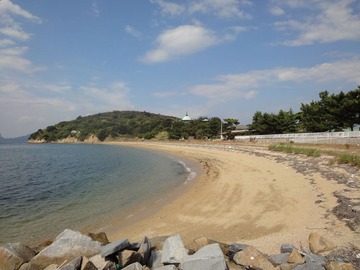
Roof of memorial building viewed from the pier.
The day I went, we were extremely fortunate to be invited inside the building, which had been opened for a special group. The interior is lined with glass cases filled with more than 2,000 small cinerary urns carefully wrapped in beautiful brocade. The respect shown in this room seemed to me to reflect the positive change in society’s attitude towards its former outcasts.
The monuments in the photo below told us more of the islanders’ story.

Stone monuments.
If someone had Hansen’s disease and was sent to a sanatorium, the rest of the family hid that fact for fear of social ostracism. The person was considered already dead and therefore no one went to collect his or her ashes when they actually passed away. In the photo above, the monument on the left is dedicated to over 600 early residents and contains the ashes and bones that did not go into the urns. The monument in the middle is dedicated to the souls of the residents’ unborn children. Couples who married were sterilized but sometimes the operation failed, resulting in pregnancy. In that case, the child had to be aborted. The stone on the right is dedicated to the first medical doctor to become sanatorium director. I was surprised to see that he was treated so specially until our guide explained that previous directors had been from the police department. It really brought home the fact that the early sanatoriums were not built to help or cure the residents but to prevent them from escaping back to the “normal” world.
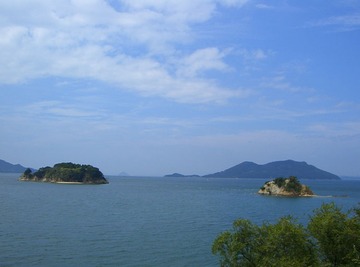
View of Ogijima back right (Photo by Kazumi)
Life was so hard in the early decades that quite a few residents did in fact attempt to escape by swimming across to other islands only to be caught and returned. They would be heading towards islands like Ogijima, the one in the far distance in the above photo. Considering the tides and the distance, it would not be an easy swim so the escapees must have been pretty desperate. Some did not make it while others did not try. They simply committed suicide by jumping in the sea. The bodies washing up on nearby shores probably deepened the fear and prejudice of local people who lived near Oshima. Living conditions on the island, particularly in the early years, were harsh, with 12 people living in 24-mat rooms (about 3 square meters/person), each with only a tiny wooden cupboard to store their few belongings. Obviously, there was no privacy. Inmates included children with leprosy or children exiled with parents who had leprosy. Some of the sanatorium employees also had children so that at one point there were three schools to segregate the different children and the island was divided into yūdoku (“toxic”) and mudoku (“non-toxic”) zones. Conditions gradually improved and each resident now has a small one-room apartment with a kitchen, a closet and a separate entrance, plus some space outside for gardening.

Resident’s impressive bonsai garden.
The sanatorium tried to be as self-sufficient in food production as possible. The residents thus grew much of their own food and there are still small vegetable plots on the island. From the bonsai collection in the photo above, you can see that some residents really take pride in their gardening skills.

White lines
The disease has impaired the eyesight of many residents. White lines on the road help them find their way and they can also tap their canes along the metal railings that line the roadside. Speakers at every intersection play music to help them keep their bearings.

Speaker and railing
Shikoku has a centuries-old pilgrimage route to 88 temples around the entire island. It takes a few months to complete on foot. These 88 temples each donated a statue to the island so that residents could complete the pilgrimage without leaving Oshima.
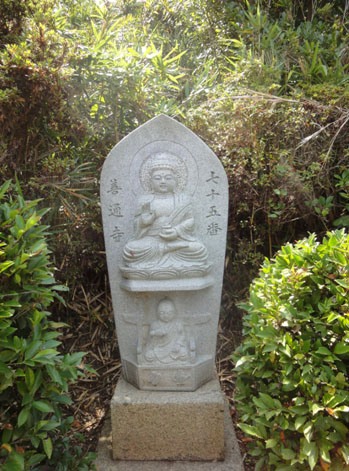
Buddhist statue donated by Zentsuji Temple, home of Kobo Daishi, the pilgrimage route foundering
In 1992, a thousand volunteers and residents worked together to create the monument below. Called Kaze no mai or “Wind Dance”, it is located behind the crematorium and contains the leftover ashes and bones of more recent residents. The name represents the islanders’ hope that at least in death they can be set free and return to their homelands.

Wind Dance monument (photos by Kazumi)
Wind Dance was built before the segregation law was repealed and it stands as a testimony to the fact that many people had been advocating the rights of sanatorium residents long before the laws changed. The monument and the art project serve as excellent reminders that changes for the better are brought about by ordinary citizens who care; by people who see beyond such differences as “disability”, “race” or “gender” to the common humanity in the heart of each one of us and are willing to stand up against injustice.

The festival ended on October 31, 2010. I am hoping that the project will continue in some form or other because it provided a great vehicle for Oshima residents and “outsiders” to come together as fellow human beings. The festival’s Japanese website says that it will at least open again for a few days in December but the details are still under discussion. Once decided the details will be posted on the Japanese festival website: http://setouchi-artfest.jp/
Here also is the list of sites that will stay open until Dec. 31:
http://setouchi-artfest.jp/images/uploads/misc/artworks_20101101_20101231r.pdf
It is still possible to visit Oshima regardless of the festival and the boat is free but you need to contact the National Sanatorium Oshima Seishoen to get permission. The phone number is 087-871-3131 (Japanese only). The facility offers a tour of the sanatorium that includes a talk by the facility doctor and time to interact with the residents (again in Japanese). You can arrange to take a group or, if you are going with only a few people, you can arrange to be included in another group’s tour. Call the facility to ask for a suitable date and time and then send a letter addressed to the director stating when you are going. The boat timetable is here:
http://www.hosp.go.jp/~osima/timetable/H221001~H230331.pdf
The Japanese website is here: http://www.hosp.go.jp/~osima/index1.html
I know for many of you this will involve getting a Japanese person to help you but it is worth the effort.
*Again, many thanks to art project director Nobuyuki Takahashi and the Koebitai volunteers for so much helpful information.

View looking out from Oshima.
Oshima Revisited: The Gentle Art Project * Part 2
Highlights
Those of us lucky enough to go to Oshima during the festival were given a 60-minute guided tour and then allowed to wander in designated places that did not intrude on the residents’ privacy if there was any time left over. The guides gave an extremely well informed account of the sanatorium’s history and the people who live here. Because there are few records, these volunteers actually gathered much of the information directly from local residents. This type of interaction with the islanders was a key part of the project. Using art as a medium, the project captured the attention of people who had been unaware of the residents’ plight and helped residents and visitors take a step towards ending social isolation.
Our first stop was a memorial building that houses cinerary urns containing the ashes of the deceased. We said prayers at the altar outside.

Roof of memorial building viewed from the pier.
The day I went, we were extremely fortunate to be invited inside the building, which had been opened for a special group. The interior is lined with glass cases filled with more than 2,000 small cinerary urns carefully wrapped in beautiful brocade. The respect shown in this room seemed to me to reflect the positive change in society’s attitude towards its former outcasts.
The monuments in the photo below told us more of the islanders’ story.

Stone monuments.
If someone had Hansen’s disease and was sent to a sanatorium, the rest of the family hid that fact for fear of social ostracism. The person was considered already dead and therefore no one went to collect his or her ashes when they actually passed away. In the photo above, the monument on the left is dedicated to over 600 early residents and contains the ashes and bones that did not go into the urns. The monument in the middle is dedicated to the souls of the residents’ unborn children. Couples who married were sterilized but sometimes the operation failed, resulting in pregnancy. In that case, the child had to be aborted. The stone on the right is dedicated to the first medical doctor to become sanatorium director. I was surprised to see that he was treated so specially until our guide explained that previous directors had been from the police department. It really brought home the fact that the early sanatoriums were not built to help or cure the residents but to prevent them from escaping back to the “normal” world.

View of Ogijima back right (Photo by Kazumi)
Life was so hard in the early decades that quite a few residents did in fact attempt to escape by swimming across to other islands only to be caught and returned. They would be heading towards islands like Ogijima, the one in the far distance in the above photo. Considering the tides and the distance, it would not be an easy swim so the escapees must have been pretty desperate. Some did not make it while others did not try. They simply committed suicide by jumping in the sea. The bodies washing up on nearby shores probably deepened the fear and prejudice of local people who lived near Oshima. Living conditions on the island, particularly in the early years, were harsh, with 12 people living in 24-mat rooms (about 3 square meters/person), each with only a tiny wooden cupboard to store their few belongings. Obviously, there was no privacy. Inmates included children with leprosy or children exiled with parents who had leprosy. Some of the sanatorium employees also had children so that at one point there were three schools to segregate the different children and the island was divided into yūdoku (“toxic”) and mudoku (“non-toxic”) zones. Conditions gradually improved and each resident now has a small one-room apartment with a kitchen, a closet and a separate entrance, plus some space outside for gardening.

Resident’s impressive bonsai garden.
The sanatorium tried to be as self-sufficient in food production as possible. The residents thus grew much of their own food and there are still small vegetable plots on the island. From the bonsai collection in the photo above, you can see that some residents really take pride in their gardening skills.

White lines
The disease has impaired the eyesight of many residents. White lines on the road help them find their way and they can also tap their canes along the metal railings that line the roadside. Speakers at every intersection play music to help them keep their bearings.

Speaker and railing
Shikoku has a centuries-old pilgrimage route to 88 temples around the entire island. It takes a few months to complete on foot. These 88 temples each donated a statue to the island so that residents could complete the pilgrimage without leaving Oshima.

Buddhist statue donated by Zentsuji Temple, home of Kobo Daishi, the pilgrimage route foundering
In 1992, a thousand volunteers and residents worked together to create the monument below. Called Kaze no mai or “Wind Dance”, it is located behind the crematorium and contains the leftover ashes and bones of more recent residents. The name represents the islanders’ hope that at least in death they can be set free and return to their homelands.

Wind Dance monument (photos by Kazumi)
Wind Dance was built before the segregation law was repealed and it stands as a testimony to the fact that many people had been advocating the rights of sanatorium residents long before the laws changed. The monument and the art project serve as excellent reminders that changes for the better are brought about by ordinary citizens who care; by people who see beyond such differences as “disability”, “race” or “gender” to the common humanity in the heart of each one of us and are willing to stand up against injustice.

The festival ended on October 31, 2010. I am hoping that the project will continue in some form or other because it provided a great vehicle for Oshima residents and “outsiders” to come together as fellow human beings. The festival’s Japanese website says that it will at least open again for a few days in December but the details are still under discussion. Once decided the details will be posted on the Japanese festival website: http://setouchi-artfest.jp/
Here also is the list of sites that will stay open until Dec. 31:
http://setouchi-artfest.jp/images/uploads/misc/artworks_20101101_20101231r.pdf
It is still possible to visit Oshima regardless of the festival and the boat is free but you need to contact the National Sanatorium Oshima Seishoen to get permission. The phone number is 087-871-3131 (Japanese only). The facility offers a tour of the sanatorium that includes a talk by the facility doctor and time to interact with the residents (again in Japanese). You can arrange to take a group or, if you are going with only a few people, you can arrange to be included in another group’s tour. Call the facility to ask for a suitable date and time and then send a letter addressed to the director stating when you are going. The boat timetable is here:
http://www.hosp.go.jp/~osima/timetable/H221001~H230331.pdf
The Japanese website is here: http://www.hosp.go.jp/~osima/index1.html
I know for many of you this will involve getting a Japanese person to help you but it is worth the effort.
*Again, many thanks to art project director Nobuyuki Takahashi and the Koebitai volunteers for so much helpful information.

View looking out from Oshima.
2010年10月27日
The GentleArtProject Revisited
Sorry for the long silence. It may seem strange to write about the Setouchi International Art Festival when it is almost over but there is one island that really needs to be shared – Oshima. I returned to the island of Oshima (See June 16 article) twice, once in September and once more at the end of October.
I found each visit profoundly thought provoking. As few people have the chance to visit this island, let me share some of the experience. There were no stunning works by famous or up-and-coming artists there. Instead the art project offered a door into the lives of people who have endured great suffering and still found meaning in life; a unique opportunity to step into the lives and history of a community that was isolated for close to a century.

Photo : Oshima Island
Oshima has been a sanatorium for people with Hansen’s disease (aka leprosy) since 1909. There was no effective cure until the early 1980s and because people mistakenly believed the disease to be highly contagious and sexually transmitted, lepers were shunned. This social stigma was aggravated in Japan by laws that enforced segregation. Those who developed the disease were wrenched from their communities, struck from the family register as though they were dead and sent to sanatoriums where they lived as outcasts, waiting to die with no hope of a cure. Some were only children. Marriage was forbidden at first and then later permitted on condition that the couples were sterilized. In the beginning, the Oshima sanatorium director came from the police department and the inhabitants were essentially prisoners, unable to leave.

Photo : View from the breakwater – dormitories in the distance.
Segregation finally ended in 1996 and Oshima residents are now free to leave the island, but most stay put, despite being cured. This is understandable when you consider that the average age of the inhabitants is 80, that many have been crippled by the disease or by aging, and that they were ostracized for much of their lives. Japanese people living in Takamatsu have told me that it is also hard for them to visit the island. Some still feel fear or guilt and others just don’t know what to expect. These factors hinder the reintegration of people from the sanatorium into society.

Photo : Catching the boat to Oshima
The Oshima art project did a tremendous job in bridging that gap by bringing people to the island and by offering a vehicle for residents to share their experience with visitors. A lot of visitors! The boat only seats 50 and it only goes 3 times a day yet the first day I went, which was a weekday, over 100 people visited the island. The project conveyed a strong sense that the residents want us to know what life was like in those difficult days of segregation before there is no one left to tell their stories. And their lives were presented in a gentle and accessible way that invited us to question and think.

Photo : Gallery 15
The exhibit at Gallery 15, entitled “Old Things, Things We Couldn’t Part With”, was a good example. Project director Nobuyuki Takahashi chose this theme because the residents were not permitted to leave anything to posterity – no children, no belongings.

Photo : Art project director Nobuyuki Takahashi
No family members came to collect their ashes when they died. Instead, the residents made informal agreements with each other to tie up any loose ends, which generally meant disposing of their belongings. Thus there are few mementos left from the past. When they learned what Takahashi wanted to do, the residents began bringing things they had kept, including the belongings of people who had passed away and things that they themselves treasured, each one with a story. These were arranged in Gallery 15, an empty dormitory, as a testimony to the residents’ lives. The tools they developed to function with their disabilities demonstrated great ingenuity and mementos, such as an enormous collection of photographs taken by a resident, suggest positive memories despite the hardship; an appreciation for life and the beauty of nature.

Photo : Former dormitory apartment housing an exhibit
Other objects quietly attested to the suffering of the island’s inhabitants. The most striking of these stands in front of the gallery – a stone table used for dissecting the bodies of residents who died.

Photo : Dissecting table in front of Gallery 15
When they entered the sanatorium, all residents had to sign a form “consenting” to be autopsied and this table was where it was done. Twenty-five years ago the table was cast from a cliff into the sea. Some residents told Takahashi it was still there, exposed at low tide, and with great effort, it was brought to shore. Its silent form, cracked down the middle, speaks volumes.

Photo : Dissecting table as it was found on the beach. (Photo by Nobuyuki Takahashi)
Considering the subject matter, this project could have been depressingly morbid, but, in fact, it wasn’t. There was no blame directed at anyone. Just an invitation to open our minds and hearts to learning about what it means to be human. As one of my Japanese friends from Takamatsu said, “Without the art festival, we never would have visited the island. We would have continued to live in separate worlds, not knowing each other. Art and the festival acted as the medium that brought us together, softening the edges to make the reality of what happened easier to bear.”

Photo : Looking out from the island (Photo by Kazumi)
Please Note:
The art project is now over, at least for the time being, but you can still visit the island. The boat is free but you will need to contact the National Sanatorium Oshima Seishoen to get permission to go. The phone number is 087-871-3131 (Japanese only). Here is the Japanese website as well: http://www.hosp.go.jp/~osima/index1.html
*Many thanks to Nobuyuki Takahashi for information and photos. Thanks also to Kazumi for sharing photos.
* Gentle Art Project (Yasashii Bijutsu Project): This term was coined by Nagoya Zokei University and is not limited to the project in Oshima. It refers to art projects in which the hospital, artists and designers collaborate to create a medical environment that promotes peace of mind and institutions that are open to the community. The university’s students and graduates are implementing such projects in other locations as well. See: http://setouchi-artfest.jp/en/artist/yasashii_bijutsu_project/
I found each visit profoundly thought provoking. As few people have the chance to visit this island, let me share some of the experience. There were no stunning works by famous or up-and-coming artists there. Instead the art project offered a door into the lives of people who have endured great suffering and still found meaning in life; a unique opportunity to step into the lives and history of a community that was isolated for close to a century.

Photo : Oshima Island
Oshima has been a sanatorium for people with Hansen’s disease (aka leprosy) since 1909. There was no effective cure until the early 1980s and because people mistakenly believed the disease to be highly contagious and sexually transmitted, lepers were shunned. This social stigma was aggravated in Japan by laws that enforced segregation. Those who developed the disease were wrenched from their communities, struck from the family register as though they were dead and sent to sanatoriums where they lived as outcasts, waiting to die with no hope of a cure. Some were only children. Marriage was forbidden at first and then later permitted on condition that the couples were sterilized. In the beginning, the Oshima sanatorium director came from the police department and the inhabitants were essentially prisoners, unable to leave.

Photo : View from the breakwater – dormitories in the distance.
Segregation finally ended in 1996 and Oshima residents are now free to leave the island, but most stay put, despite being cured. This is understandable when you consider that the average age of the inhabitants is 80, that many have been crippled by the disease or by aging, and that they were ostracized for much of their lives. Japanese people living in Takamatsu have told me that it is also hard for them to visit the island. Some still feel fear or guilt and others just don’t know what to expect. These factors hinder the reintegration of people from the sanatorium into society.

Photo : Catching the boat to Oshima
The Oshima art project did a tremendous job in bridging that gap by bringing people to the island and by offering a vehicle for residents to share their experience with visitors. A lot of visitors! The boat only seats 50 and it only goes 3 times a day yet the first day I went, which was a weekday, over 100 people visited the island. The project conveyed a strong sense that the residents want us to know what life was like in those difficult days of segregation before there is no one left to tell their stories. And their lives were presented in a gentle and accessible way that invited us to question and think.

Photo : Gallery 15
The exhibit at Gallery 15, entitled “Old Things, Things We Couldn’t Part With”, was a good example. Project director Nobuyuki Takahashi chose this theme because the residents were not permitted to leave anything to posterity – no children, no belongings.

Photo : Art project director Nobuyuki Takahashi
No family members came to collect their ashes when they died. Instead, the residents made informal agreements with each other to tie up any loose ends, which generally meant disposing of their belongings. Thus there are few mementos left from the past. When they learned what Takahashi wanted to do, the residents began bringing things they had kept, including the belongings of people who had passed away and things that they themselves treasured, each one with a story. These were arranged in Gallery 15, an empty dormitory, as a testimony to the residents’ lives. The tools they developed to function with their disabilities demonstrated great ingenuity and mementos, such as an enormous collection of photographs taken by a resident, suggest positive memories despite the hardship; an appreciation for life and the beauty of nature.

Photo : Former dormitory apartment housing an exhibit
Other objects quietly attested to the suffering of the island’s inhabitants. The most striking of these stands in front of the gallery – a stone table used for dissecting the bodies of residents who died.

Photo : Dissecting table in front of Gallery 15
When they entered the sanatorium, all residents had to sign a form “consenting” to be autopsied and this table was where it was done. Twenty-five years ago the table was cast from a cliff into the sea. Some residents told Takahashi it was still there, exposed at low tide, and with great effort, it was brought to shore. Its silent form, cracked down the middle, speaks volumes.

Photo : Dissecting table as it was found on the beach. (Photo by Nobuyuki Takahashi)
Considering the subject matter, this project could have been depressingly morbid, but, in fact, it wasn’t. There was no blame directed at anyone. Just an invitation to open our minds and hearts to learning about what it means to be human. As one of my Japanese friends from Takamatsu said, “Without the art festival, we never would have visited the island. We would have continued to live in separate worlds, not knowing each other. Art and the festival acted as the medium that brought us together, softening the edges to make the reality of what happened easier to bear.”

Photo : Looking out from the island (Photo by Kazumi)
Please Note:
The art project is now over, at least for the time being, but you can still visit the island. The boat is free but you will need to contact the National Sanatorium Oshima Seishoen to get permission to go. The phone number is 087-871-3131 (Japanese only). Here is the Japanese website as well: http://www.hosp.go.jp/~osima/index1.html
*Many thanks to Nobuyuki Takahashi for information and photos. Thanks also to Kazumi for sharing photos.
* Gentle Art Project (Yasashii Bijutsu Project): This term was coined by Nagoya Zokei University and is not limited to the project in Oshima. It refers to art projects in which the hospital, artists and designers collaborate to create a medical environment that promotes peace of mind and institutions that are open to the community. The university’s students and graduates are implementing such projects in other locations as well. See: http://setouchi-artfest.jp/en/artist/yasashii_bijutsu_project/
2010年09月16日
Art Setouchi in Ogijima 2
Having dealt with the logistics in my last article, it’s now time for the fun stuff – a look at some of the sights/sites in Ogijima.
Here we are on the 8AM ferry to Ogijima to enjoy a great collection of diverse art styles and approaches in a fantastic setting…
Photo : On our way
…such as Onba Factory (see May 20 article). Onba, which means “stroller”, is the main means of transport on the island. The Onba Factory concept is to transform the islanders’ strollers into works of art in collaboration with the owners. I was really happy to see that they’ve had a steady stream of customers and to find their fun designs parked in front of people’s homes or being pushed along the street. For example:
Photos : An Onba with customized brake
Photo : An Onba taking a break
And here are some of the playful versions displayed at Onba Factory (Site #51).
Photo : Deco truck stroller
And
Photo : Iron bead stroller
Photo 05 Iron bead stroller front view
And
Photo : Horse-drawn wagon stroller
I also dropped in again at Kawashima & Dream Friends (Site #46), partly because I wanted to eat another Meon burger and partly to see how the Memory Drops display had evolved since I was last there. It’s very participatory. Visitors can make their own memory drops to take home or leave at the site so the collection is growing.
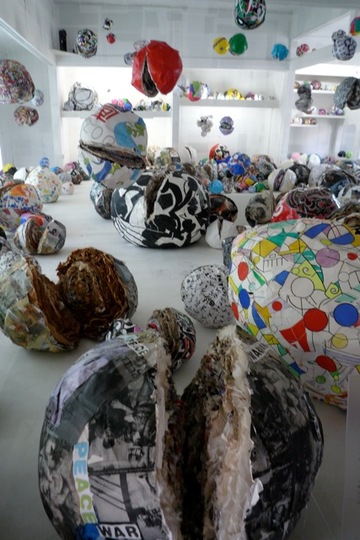
Photo : Memory Drops
I was very lucky to find the artist, Takeshi Kawashima, there and I had the chance to chat with him and his lovely wife.
Photo : The artist and the work
*Thanks to Lara for the above 2 photos.
The Kawashimas live in New York very near ground zero. The shock of the terrorist attack inspired Kawashima to begin creating Memory Drops and the exhibit carries a poignant message for peace.

Photo : Memory Drop
I loved their approach: “You don’t have to understand art. Just feel it and enjoy it.” That spirit is really reflected in this site and in this art festival.
Photo : You and I Pillar 2010
The “You and I [Nawa] Ogijima Pillar 2010” designed by Mariyo Yagi is on the same site. Made with old cloth and other materials collected from the island, this, too, was made with islanders and volunteers, nicely dovetailing with the collaborative nature of the Memory Drop project.

Photo : You and I Pillar 2010
*Thanks to Pat for this shot.
One site I was really looking forward to was the Maison de Urushi Project (Site #50) and it did not disappoint. Kagawa prefecture where much of this festival is being held has some of the best lacquer artists in Japan and a wide range of techniques. Lacquer artists paneled two rooms of this house with lacquer, one black, one white – and they are stunning, especially when you know how painstaking lacquer work is.
Photo : Maison de Urushi white room
The artist on duty was really informative and willing to answer questions and there is a very good English pamphlet available. To quote “As a material, a technique and a philosophy for making things, lacquer has never been more worthy of serious consideration, not only from the standpoint of tradition, but also for its eco-friendliness and durability.” When I went, they were letting visitors add to the black room by sandpapering their own spot onto a panel. And in another room they were serving tea and traditional Japanese sweets on lacquer ware for JPY 500.
Photo : Maison de Urushi black room
There’s just so much to see on Ogijima. I loved the whimsical music made by Akinori Matsumoto’s Sound Scenes in Ogijima (#47)
Photo : #47 Sound Scenes in Ogijima
And stumbling across artworks in unexpected places like Rikuji Makabe’s walls (Wallalley #58)
Photo : Wallalley
and Tomoko Taniguchi’s Organ (#56)
Photo : Organ
Best of all are the people. Like this woman resting by Art Site #55. We joined her in the welcome shade and had a great chat. She assured us that the islanders are all good people, not a bad one among them, and I believe her. Many islanders are elderly and live on their own but they all help each other out.
Photo : Stopping for a chat
And, finally, the intriguing glimpses of island life and history, like this pirate-proof gate.

Photo : Pirate-proof gate
The owner explained that pirates raided the island fairly regularly up until the early 20th century. With the men and women out working the fields, the grandparents and young children were left vulnerable at home. People with anything to steal built their entranceways like this so that the house could be easily defended from inside.

Photo : Gate close up
*Above 2 shots also courtesy of Lara.
I’m sure by now you’ve realized that there’s far too much worth seeing than a single article can cover. I hope you have the chance to go and see for yourself.
2010年09月02日
Art Setouchi in Ogijima 1
Over a month has passed since Setouchi International Art Festival began and I have been making steady progress in visiting each island. Although each is special, there’s one I keep going back to – Ogijima. I’d like to share some tips for getting around the island and, in the next article, some of its special charms. (For tips on navigating the festival in general, check out Pat’s article at http://pat.ashita-sanuki.jp/e308385.html . For helpful advice on planning an itinerary for the festival as a whole, check out the following site: http://onafloatingbridge.com/slow-travel/getting-around-setouchi-intl-art-festival )
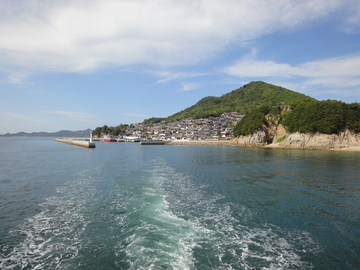
Photo : Ogijima port and village
Getting Around: The Japanese guidebook says you can see all the art sites on Ogijima in between 1.5 to 2.5 hours. I have not succeeded in doing that yet and I’ve been 3 times. I suspect it would be possible if I were more Japanese or business-like in my approach but that’s not why I go! Personally I’d allow at least 4 hours with time to stop for lunch, for beverages, for hobnobbing with the locals and other travelers, and to do some art. If you want to take a swim or see the rest of the island, give yourself a day. At the Ogijima port cultural exchange center, Art Site #43, volunteers (some English-speaking) will give you a recommended route designed to fit the amount of time you have. If you’re like me and don’t like crowds, follow the route in reverse order and don’t worry about the time. The center also sells art festival passports, maps, souvenirs, etc.
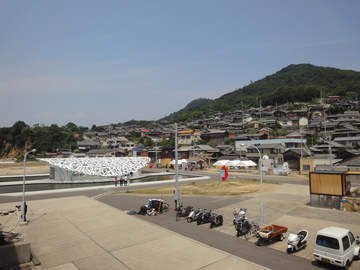
Photo : #43 cultural exchange center at the port
There are frequent signs along the way so you won’t get too lost and if you do, the islanders and visitors are helpful and friendly.
Keeping Cool: The heat wave that has gripped Japan for the last month looks like it will continue until at least mid-September. If you are traveling when it’s hot, I recommend taking the 8:00 ferry because it gets you to Ogijima while there is still shade. The village meanders up a very steep hill at the top of which is a shrine with Art Site #57.

Photo : Hill to the shrine

Photo : Steps to the shrine
If you climb up there first, you can spend the rest of your time wandering downhill, which requires less exertion and lets you enjoy the shade of the houses.

Photo : Resting at the top of the hill Site #57
Take some towels and one or two drinks with you. You can buy more drinks at vending machines, a small local store and at some art sites (pricier but good).
Food and Drink: Speaking of which, Onba Factory (Site #51) makes a very cool and refreshing homemade ginger ale for 500 yen as well as homemade honey and lemon squash. They also serve beer and nibbles. It’s a limited menu but they offer welcome shade and a fan-induced breeze plus a great view of the sea. Admission is free so you can visit as often as you like.

Photo : #51entrance to Onba Factory
Dream Café outside Site # 46 Kawashima & Dream Friends has a great burger for 580 yen. The patty is made of fish paste, which I know sounds terrible but it’s actually delicious. The salad with octopus and the soymilk ice cream are also excellent.

Photo : Dream Café

Photo : Meon burger in the making
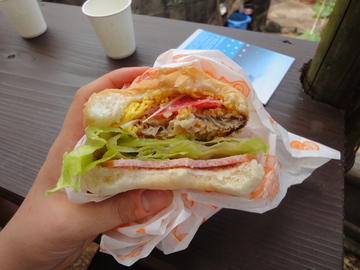
Photo : Meon burger in the eating
Personally, I also like the little restaurant facing the port, which serves simple fare like fried noodles with ingredients harvested here on the island but I haven’t had a chance to go since the festival started. Fellow blogger Pat stumbled on another local eatery he claims is great with lower prices. It’s in a black wooden converted house, located at the port 45 degrees to the right when you are standing at Site #43 facing the village. Pat says it serves snow cones and fish dishes (an example shown below). I’m looking forward to trying it next time.
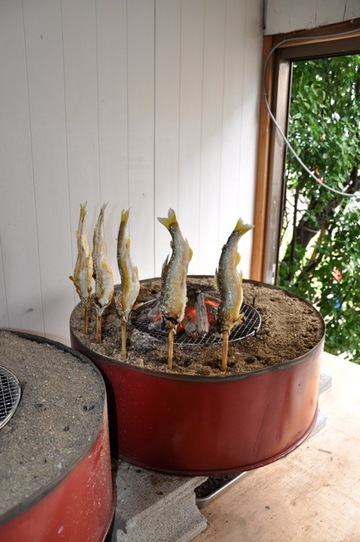
Photo : of fish cooking.
Another place I haven’t tried yet but want to is the Urushi House Project (Site # 50) where they serve Japanese tea and sweets. This site is air-conditioned by the way. Drop in when you feel ready to melt. They told me no admission fee is required here either. Two local inns serve more substantial meals, although the official Setouchi Art guidebook says that advance reservations are required. And the visitors’ center also sells limited amounts of takeout food, such as a local delicacy – octopus rice.
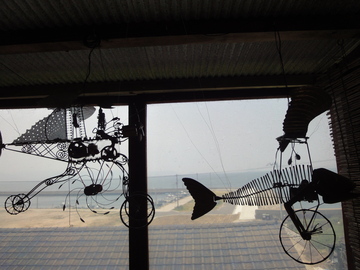
Photo : Site #45 at Madoka. View through the Karakurin by Takashi Imura
Accommodation: Last but not least, for those of you who want to stay, I discovered a local temple between the two Site #47 locations that lets people stay overnight for only JPY 1,500 (TEL: 087-840-9612). I’m guessing that the accommodation is somewhat youth hostel like but the people seemed very friendly. You need to bring your own food but they’ll let you use the kitchen. Accommodation at the two local inns costs JPY 8,000 for one night including breakfast and dinner, reservations required. (Madoka TEL: 087-873-0703. Hamaue Ryokan TEL: 087-873-0833.)
And that’s it for logistics. Now all you have to do is hop on the ferry and enjoy!
For ferry schedules and fares see http://setouchi-artfest.jp/en/access/islands/#r9 or under Access at the English Art Setouchi site: http://setouchi-artfest.jp/en/
(Many thanks to fellow blogger Pat Scanlon for the photos of Dream Café, Meon burger in the making and roasting fish, and to Hiroko for the one of us resting at the top of the hill.)
Photo : Ogijima port and village
Getting Around: The Japanese guidebook says you can see all the art sites on Ogijima in between 1.5 to 2.5 hours. I have not succeeded in doing that yet and I’ve been 3 times. I suspect it would be possible if I were more Japanese or business-like in my approach but that’s not why I go! Personally I’d allow at least 4 hours with time to stop for lunch, for beverages, for hobnobbing with the locals and other travelers, and to do some art. If you want to take a swim or see the rest of the island, give yourself a day. At the Ogijima port cultural exchange center, Art Site #43, volunteers (some English-speaking) will give you a recommended route designed to fit the amount of time you have. If you’re like me and don’t like crowds, follow the route in reverse order and don’t worry about the time. The center also sells art festival passports, maps, souvenirs, etc.
Photo : #43 cultural exchange center at the port
There are frequent signs along the way so you won’t get too lost and if you do, the islanders and visitors are helpful and friendly.
Keeping Cool: The heat wave that has gripped Japan for the last month looks like it will continue until at least mid-September. If you are traveling when it’s hot, I recommend taking the 8:00 ferry because it gets you to Ogijima while there is still shade. The village meanders up a very steep hill at the top of which is a shrine with Art Site #57.
Photo : Hill to the shrine
Photo : Steps to the shrine
If you climb up there first, you can spend the rest of your time wandering downhill, which requires less exertion and lets you enjoy the shade of the houses.
Photo : Resting at the top of the hill Site #57
Take some towels and one or two drinks with you. You can buy more drinks at vending machines, a small local store and at some art sites (pricier but good).
Food and Drink: Speaking of which, Onba Factory (Site #51) makes a very cool and refreshing homemade ginger ale for 500 yen as well as homemade honey and lemon squash. They also serve beer and nibbles. It’s a limited menu but they offer welcome shade and a fan-induced breeze plus a great view of the sea. Admission is free so you can visit as often as you like.
Photo : #51entrance to Onba Factory
Dream Café outside Site # 46 Kawashima & Dream Friends has a great burger for 580 yen. The patty is made of fish paste, which I know sounds terrible but it’s actually delicious. The salad with octopus and the soymilk ice cream are also excellent.

Photo : Dream Café

Photo : Meon burger in the making
Photo : Meon burger in the eating
Personally, I also like the little restaurant facing the port, which serves simple fare like fried noodles with ingredients harvested here on the island but I haven’t had a chance to go since the festival started. Fellow blogger Pat stumbled on another local eatery he claims is great with lower prices. It’s in a black wooden converted house, located at the port 45 degrees to the right when you are standing at Site #43 facing the village. Pat says it serves snow cones and fish dishes (an example shown below). I’m looking forward to trying it next time.

Photo : of fish cooking.
Another place I haven’t tried yet but want to is the Urushi House Project (Site # 50) where they serve Japanese tea and sweets. This site is air-conditioned by the way. Drop in when you feel ready to melt. They told me no admission fee is required here either. Two local inns serve more substantial meals, although the official Setouchi Art guidebook says that advance reservations are required. And the visitors’ center also sells limited amounts of takeout food, such as a local delicacy – octopus rice.
Photo : Site #45 at Madoka. View through the Karakurin by Takashi Imura
Accommodation: Last but not least, for those of you who want to stay, I discovered a local temple between the two Site #47 locations that lets people stay overnight for only JPY 1,500 (TEL: 087-840-9612). I’m guessing that the accommodation is somewhat youth hostel like but the people seemed very friendly. You need to bring your own food but they’ll let you use the kitchen. Accommodation at the two local inns costs JPY 8,000 for one night including breakfast and dinner, reservations required. (Madoka TEL: 087-873-0703. Hamaue Ryokan TEL: 087-873-0833.)
And that’s it for logistics. Now all you have to do is hop on the ferry and enjoy!
For ferry schedules and fares see http://setouchi-artfest.jp/en/access/islands/#r9 or under Access at the English Art Setouchi site: http://setouchi-artfest.jp/en/
(Many thanks to fellow blogger Pat Scanlon for the photos of Dream Café, Meon burger in the making and roasting fish, and to Hiroko for the one of us resting at the top of the hill.)
2010年08月16日
Art Setouchi in Megijima 2
Art Site Logistics and Info
If you want to see all the art sites on Megijima, it will take about half a day, allowing time for resting and eating. Seven of the sites are within 1 to 5 minutes walk from the port. Two are at the top of the hill by the cave (10-minute bus ride up, 45 minutes at the top, 10-minute bus ride back). I went on the 10:00 ferry and returned on the 13:00 but had to go very slowly due to the heat – 35ºC. Thank goodness the video art exhibits in Fukutake House are air-conditioned! At that pace, I only managed to see 5 out of 9 sites. During August and September, which can be very hot, it’s probably wiser to take the 8:00 AM ferry and do most of your wandering before it heats up. Then have a picnic under the pines along the beach or eat at a restaurant (see previous post). Alternatively, you could either take the 15:10 ferry from Takamatsu or go to Ogijima first and stop by Megijima in the late afternoon to visit the sites that close at 17:00 and then check out those sites that remain open until 20:30. There are photos and brief explanations of each work at the art festival’s official site:
http://setouchi-artfest.jp/en/artworks/island/venue-megijima/. Below I’ve added some extra information concerning 3 sites.
Site #38 Leandro Erlich (Argentina)
The Presence of Absence
Erlich renovated an old 2-story building to create two installations, the Twofold Teahouse and a Zen-like rock garden called Invisible. Both play interesting tricks with perception. The works were inspired by the building itself, in which the artist felt the presence and history of the many generations that once lived there. Hence the overall title, The Presence of Absence. The building also houses a small library space and a restaurant/cafe (IARA). It was not air conditioned when I went. Though it does have some breeze, in summer it’s nicer to view the two artworks before the restaurant opens (at 11:00) and then stay on for lunch or refreshment before it heats up. After that, visit the nearby Fukutake House, which houses solo exhibits by a variety of artists and has several airconditioned exhibits that provide a refuge from the heat. Or go jump in the sea!
Hours: 9:00-20:30 (Restaurant: 11:00-20:30)

The Presence of Absence
Site #39 Harumi Yukutake (Japan)
Equipoise
I visited this site while it was under construction and it really was painstaking work. The artist spent about 4 months on the island, hand-shaping over 10,000 rectangular strips of mirrored glass and stringing them from the ceiling of a 2-story storehouse to make a glass tube. You can walk right in and enjoy the reflections and the light shimmering in the breeze (there’s a fan in the ceiling). Entering through a second door you can also view the work from behind and above. The building was in a state of partial decay and Yukutake chose to display the craftsmanship of the original builders by reinforcing the exposed beams and latticework with transparent material. I’d like to try viewing it at different times of day because the effect will change with the light.
Hours: 9:00-20:30
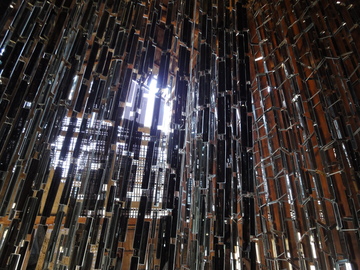

Site #36 MEGI HOUSE by Art Project Team, Aichi Prefectural University of Fine Arts and Music
This is another site I visited while it was still in process and I was very impressed with the result this time around. The team of university students and professors has successfully transformed a traditional old house and high stonewall into a stage, reusing secondhand materials such as copper plates, discarded beams and even what looks like the top of a rice winnower to make a window slit. They started in April 2009 and plan to continue working on this site and presenting art and concerts here for the next 10 years. Concerts and workshops will be held frequently during Art Setouchi (see below).
Hours: 9:00 – 20:30
MEGI HOUSE Events: Details are posted on http://setouchi-artfest.jp/en/events/ (scroll down to Art Project Team). To this, I’ve added extra info below from the project’s Japanese website. Tickets can be bought at the Takamatsu Port General Information Center or at the Megijima ferry terminal building – Oni no Yakata.

Oni no Yakata
Mini-obon concert: Aug. 13 (Fri.). Featuring the islanders and university students with a local musician who graduated from this university. Looks like it’s free but only open to non-participants if there is extra room. The Takamatsu Summer Festival Fireworks display starts after the concert. According to a Megijima resident, it’s worth going on this day just to see the fireworks anyway. The last ferry leaves at 21:00 after the display.
The Sound of Tactics: Aug. 22 (Sun.) A collaborative workshop with students of music and art from the graduate program. Time not decided yet. No fee listed.
Yorokobi no Shima (Island of Joy): Aug. 28 (Sat.) Pianist and associate professor Jun Kitazumi performs Debussy, Hayashi Hikaru, and Bartok. Capacity: 40. Doors open 18:00, Starts 18:30. Ends about 20:00. Admission: JPY 1,500; with art passport only JPY 1,000.
Percussive Earth: Sept. 23 (Thurs.) Percussion performance. Capacity: 70. Doors open 16:45. Starts 17:15. Ends about 18:45. Admission: JPY 2,000; with art passport JPY 1,500.
MatsuRHYTHM: Sept. 26 (Sun.) Participatory percussion performance using instruments made from bamboo from Megijima. Performers, including islanders and visitors, will perform as they walk through the streets. Instrument making workshop and practice on Sept. 25. No fee listed. Will be changed to Oct. 2 and 3 in event of rain.
MEGI (Music and Electrically Generated Information): Oct. 10 (Sun.) Computer generated music and digital art, live performance. Doors open 18:00. Starts 18:30. Ends about 20:00. In case of rain, will be held the following day. Admission: JPY 2,000; with art passport JPY 1,500.
Umi no Fanfare (Sea Fanfare): Oct. 31 (Sun.) Brass band concerts in several outdoor locations, including Megijima port. Special fanfare composed for the event. Starts 13:00 (Ending time undecided). Will be held in Megijima school gymnasium in event of rain (capacity 200). No fee listed.
If you want to see all the art sites on Megijima, it will take about half a day, allowing time for resting and eating. Seven of the sites are within 1 to 5 minutes walk from the port. Two are at the top of the hill by the cave (10-minute bus ride up, 45 minutes at the top, 10-minute bus ride back). I went on the 10:00 ferry and returned on the 13:00 but had to go very slowly due to the heat – 35ºC. Thank goodness the video art exhibits in Fukutake House are air-conditioned! At that pace, I only managed to see 5 out of 9 sites. During August and September, which can be very hot, it’s probably wiser to take the 8:00 AM ferry and do most of your wandering before it heats up. Then have a picnic under the pines along the beach or eat at a restaurant (see previous post). Alternatively, you could either take the 15:10 ferry from Takamatsu or go to Ogijima first and stop by Megijima in the late afternoon to visit the sites that close at 17:00 and then check out those sites that remain open until 20:30. There are photos and brief explanations of each work at the art festival’s official site:
http://setouchi-artfest.jp/en/artworks/island/venue-megijima/. Below I’ve added some extra information concerning 3 sites.
Site #38 Leandro Erlich (Argentina)
The Presence of Absence
Erlich renovated an old 2-story building to create two installations, the Twofold Teahouse and a Zen-like rock garden called Invisible. Both play interesting tricks with perception. The works were inspired by the building itself, in which the artist felt the presence and history of the many generations that once lived there. Hence the overall title, The Presence of Absence. The building also houses a small library space and a restaurant/cafe (IARA). It was not air conditioned when I went. Though it does have some breeze, in summer it’s nicer to view the two artworks before the restaurant opens (at 11:00) and then stay on for lunch or refreshment before it heats up. After that, visit the nearby Fukutake House, which houses solo exhibits by a variety of artists and has several airconditioned exhibits that provide a refuge from the heat. Or go jump in the sea!
Hours: 9:00-20:30 (Restaurant: 11:00-20:30)
The Presence of Absence
Site #39 Harumi Yukutake (Japan)
Equipoise
I visited this site while it was under construction and it really was painstaking work. The artist spent about 4 months on the island, hand-shaping over 10,000 rectangular strips of mirrored glass and stringing them from the ceiling of a 2-story storehouse to make a glass tube. You can walk right in and enjoy the reflections and the light shimmering in the breeze (there’s a fan in the ceiling). Entering through a second door you can also view the work from behind and above. The building was in a state of partial decay and Yukutake chose to display the craftsmanship of the original builders by reinforcing the exposed beams and latticework with transparent material. I’d like to try viewing it at different times of day because the effect will change with the light.
Hours: 9:00-20:30
Site #36 MEGI HOUSE by Art Project Team, Aichi Prefectural University of Fine Arts and Music
This is another site I visited while it was still in process and I was very impressed with the result this time around. The team of university students and professors has successfully transformed a traditional old house and high stonewall into a stage, reusing secondhand materials such as copper plates, discarded beams and even what looks like the top of a rice winnower to make a window slit. They started in April 2009 and plan to continue working on this site and presenting art and concerts here for the next 10 years. Concerts and workshops will be held frequently during Art Setouchi (see below).
Hours: 9:00 – 20:30
MEGI HOUSE Events: Details are posted on http://setouchi-artfest.jp/en/events/ (scroll down to Art Project Team). To this, I’ve added extra info below from the project’s Japanese website. Tickets can be bought at the Takamatsu Port General Information Center or at the Megijima ferry terminal building – Oni no Yakata.

Oni no Yakata
Mini-obon concert: Aug. 13 (Fri.). Featuring the islanders and university students with a local musician who graduated from this university. Looks like it’s free but only open to non-participants if there is extra room. The Takamatsu Summer Festival Fireworks display starts after the concert. According to a Megijima resident, it’s worth going on this day just to see the fireworks anyway. The last ferry leaves at 21:00 after the display.
The Sound of Tactics: Aug. 22 (Sun.) A collaborative workshop with students of music and art from the graduate program. Time not decided yet. No fee listed.
Yorokobi no Shima (Island of Joy): Aug. 28 (Sat.) Pianist and associate professor Jun Kitazumi performs Debussy, Hayashi Hikaru, and Bartok. Capacity: 40. Doors open 18:00, Starts 18:30. Ends about 20:00. Admission: JPY 1,500; with art passport only JPY 1,000.
Percussive Earth: Sept. 23 (Thurs.) Percussion performance. Capacity: 70. Doors open 16:45. Starts 17:15. Ends about 18:45. Admission: JPY 2,000; with art passport JPY 1,500.
MatsuRHYTHM: Sept. 26 (Sun.) Participatory percussion performance using instruments made from bamboo from Megijima. Performers, including islanders and visitors, will perform as they walk through the streets. Instrument making workshop and practice on Sept. 25. No fee listed. Will be changed to Oct. 2 and 3 in event of rain.
MEGI (Music and Electrically Generated Information): Oct. 10 (Sun.) Computer generated music and digital art, live performance. Doors open 18:00. Starts 18:30. Ends about 20:00. In case of rain, will be held the following day. Admission: JPY 2,000; with art passport JPY 1,500.
Umi no Fanfare (Sea Fanfare): Oct. 31 (Sun.) Brass band concerts in several outdoor locations, including Megijima port. Special fanfare composed for the event. Starts 13:00 (Ending time undecided). Will be held in Megijima school gymnasium in event of rain (capacity 200). No fee listed.
2010年08月10日
Art Setouchi in Megijima 1
The Setouchi International Art Festival is now well underway and I have been to several islands since it started. One of those was Megijima, the closest of the 7 art islands to Takamatsu. Japan-guide gives a good overview of the festival at http://www.japan-guide.com/e/e5410.html, including Megijima at http://www.japan-guide.com/e/e5412.html. So in this post I’ll try to provide extra details that could be helpful in getting around the island. I’ll follow with a post on tips for visiting the art sites in Megijima and glimpses of a few sites.
Island Logistics
Megijima is less than 20 minutes away from Takamatsu port by ferry. The island’s fishing village is very picturesque with high stonewalls called “Ōte” that protect it from winter gales. A beautiful sandy beach lies barely 5-minutes walk from the port and it has a large pine grove nearby with welcome shade. I really enjoyed just strolling down the village streets and along the beach, taking in the scenery and chatting with the occasional villager. Like all the islands, the population is decreasing and aging, with 60% of its 199 residents over 65 years of age. The nursery school closed over 8 years ago and the elementary school over 5 years ago when the last students graduated. In July and August, however, the population swells with swimmers, sunbathers, fishermen and campers. The beach is really nice so consider taking swimsuits, etc. (Swimming season lasts to the end of August when stinging jellyfish start floating in.)
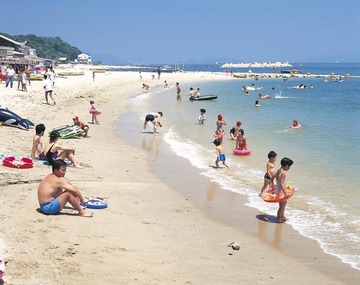
Megijima Beach
The Ogres’ Cave near the top of the high hill above the beach is a popular sightseeing spot. Admission normally costs JPY 500 for adults (seniors JPY 450, JPY 250 or less for children depending on their age) but with a festival passport you can get in for only JPY 200. It’s quite impressive for a manmade cave (400 meters deep with more than 10 chambers and covering an area of 4000 square meters) and was reportedly carved out by pirates centuries ago. The bus up to the cave is conveniently timed to coincide with ferry arrivals so if you want to see the cave, the lookout point or even just the 2 art sites at the cave entrance, take the bus when you arrive (Adult JPY 300 1-way; Children 2 years and up JPY 150 1-way). You can catch the bus from behind the Oni no Yakata information center at the port.

The Ogre'sCave
Oni no Yakata Information Center:Open 9:00 to 21:00 during the Art Festival. Stop here first if you need any information, etc. It was well staffed when I went. They have art festival passports, tickets for the bus as well as for individual art sites and events, maps with some English, rent-a-cycles (regular: JPY 200; mountain bike: JPY 300; moped: JPY 500), flush toilets, drink machines and a simple cafeteria (open 11:00 – 15:00).

Oni no Yakata Information Cwnter
Fireworks August 13:Megijima is reportedly a great place to watch the annual Takamatsu Summer Festival Fireworks display. The last ferry is at 21:00 but if it’s crowded, they will add an extra ferry.
Food and Drink
Oni no Yakata:11:00-15:00; light meals such as noodles (JPY 350 and up) and beverages. Usually closed on Tuesdays but open 7 days/week during the festival. (Closed January through February.)
IARA (Leandro Erlich Site #38): 11:00-20:30 Lunch: cheese panini (JPY700), beef curry (JPY 900), paella or pasta (JPY 1,200), sweets, beverages. (The curry was good.) Dinner: full course JPY 3,200


IARAsMenu
Fukutake House:
One of the art installations is also a café. JPY 500/drink.
Beachside Stalls: Open till about the end of August. Regular fare like noodles fried, cold or in soup, with prices from JPY 400 and up as well as ice cream, drinks, etc.
Camping: There are campgrounds in the pine grove right by the beach (150 meters from the port). You must bring your own tent and gear but it’s only JPY 200/adult and JPY 100/child. The site is run by the Seniors’ Association. Usually the people in charge are sitting under the pine trees but if you don’t see them, set up anywhere under the pines and they will come around later to take the fee. The prefectural campsite at the far end of the island is free. (Contact: 087-873-0402; Japanese only.)
Ferry Schedule: http://setouchi-artfest.jp/en/access/islands/#r9 (Or under Access at the English Art Setouchi site: http://setouchi-artfest.jp/en/ )
Fares: Adults JPY 200 1-way; Children JPY 100 1-way. These are special art festival rates. Try to get there at least 20 minutes before your ferry in summer and on weekends because the line up for tickets is quite long. The day I went, they had set up a table outside to sell tickets in addition to the ticket office.
Pier and Ticket Office: Located directly across the intersection from Tamamo Park and the ANA Clement Hotel behind the small brick ferry terminal. The tickets are sold from a window around the back of the terminal facing the piers. The map below is courtesy of the Takamatsu International Association. (I don’t think the pier is called 1st Pier but you can see where the ticket office is.)
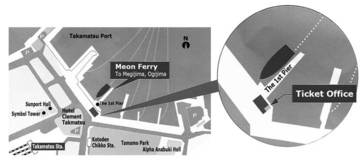
Island Logistics
Megijima is less than 20 minutes away from Takamatsu port by ferry. The island’s fishing village is very picturesque with high stonewalls called “Ōte” that protect it from winter gales. A beautiful sandy beach lies barely 5-minutes walk from the port and it has a large pine grove nearby with welcome shade. I really enjoyed just strolling down the village streets and along the beach, taking in the scenery and chatting with the occasional villager. Like all the islands, the population is decreasing and aging, with 60% of its 199 residents over 65 years of age. The nursery school closed over 8 years ago and the elementary school over 5 years ago when the last students graduated. In July and August, however, the population swells with swimmers, sunbathers, fishermen and campers. The beach is really nice so consider taking swimsuits, etc. (Swimming season lasts to the end of August when stinging jellyfish start floating in.)

Megijima Beach
The Ogres’ Cave near the top of the high hill above the beach is a popular sightseeing spot. Admission normally costs JPY 500 for adults (seniors JPY 450, JPY 250 or less for children depending on their age) but with a festival passport you can get in for only JPY 200. It’s quite impressive for a manmade cave (400 meters deep with more than 10 chambers and covering an area of 4000 square meters) and was reportedly carved out by pirates centuries ago. The bus up to the cave is conveniently timed to coincide with ferry arrivals so if you want to see the cave, the lookout point or even just the 2 art sites at the cave entrance, take the bus when you arrive (Adult JPY 300 1-way; Children 2 years and up JPY 150 1-way). You can catch the bus from behind the Oni no Yakata information center at the port.

The Ogre'sCave
Oni no Yakata Information Center:Open 9:00 to 21:00 during the Art Festival. Stop here first if you need any information, etc. It was well staffed when I went. They have art festival passports, tickets for the bus as well as for individual art sites and events, maps with some English, rent-a-cycles (regular: JPY 200; mountain bike: JPY 300; moped: JPY 500), flush toilets, drink machines and a simple cafeteria (open 11:00 – 15:00).

Oni no Yakata Information Cwnter
Fireworks August 13:Megijima is reportedly a great place to watch the annual Takamatsu Summer Festival Fireworks display. The last ferry is at 21:00 but if it’s crowded, they will add an extra ferry.
Food and Drink
Oni no Yakata:11:00-15:00; light meals such as noodles (JPY 350 and up) and beverages. Usually closed on Tuesdays but open 7 days/week during the festival. (Closed January through February.)
IARA (Leandro Erlich Site #38): 11:00-20:30 Lunch: cheese panini (JPY700), beef curry (JPY 900), paella or pasta (JPY 1,200), sweets, beverages. (The curry was good.) Dinner: full course JPY 3,200
IARAsMenu
Fukutake House:
One of the art installations is also a café. JPY 500/drink.
Beachside Stalls: Open till about the end of August. Regular fare like noodles fried, cold or in soup, with prices from JPY 400 and up as well as ice cream, drinks, etc.
Camping: There are campgrounds in the pine grove right by the beach (150 meters from the port). You must bring your own tent and gear but it’s only JPY 200/adult and JPY 100/child. The site is run by the Seniors’ Association. Usually the people in charge are sitting under the pine trees but if you don’t see them, set up anywhere under the pines and they will come around later to take the fee. The prefectural campsite at the far end of the island is free. (Contact: 087-873-0402; Japanese only.)
Ferry Schedule: http://setouchi-artfest.jp/en/access/islands/#r9 (Or under Access at the English Art Setouchi site: http://setouchi-artfest.jp/en/ )
Fares: Adults JPY 200 1-way; Children JPY 100 1-way. These are special art festival rates. Try to get there at least 20 minutes before your ferry in summer and on weekends because the line up for tickets is quite long. The day I went, they had set up a table outside to sell tickets in addition to the ticket office.
Pier and Ticket Office: Located directly across the intersection from Tamamo Park and the ANA Clement Hotel behind the small brick ferry terminal. The tickets are sold from a window around the back of the terminal facing the piers. The map below is courtesy of the Takamatsu International Association. (I don’t think the pier is called 1st Pier but you can see where the ticket office is.)





